Bosch Power Tools CM12 User Manual
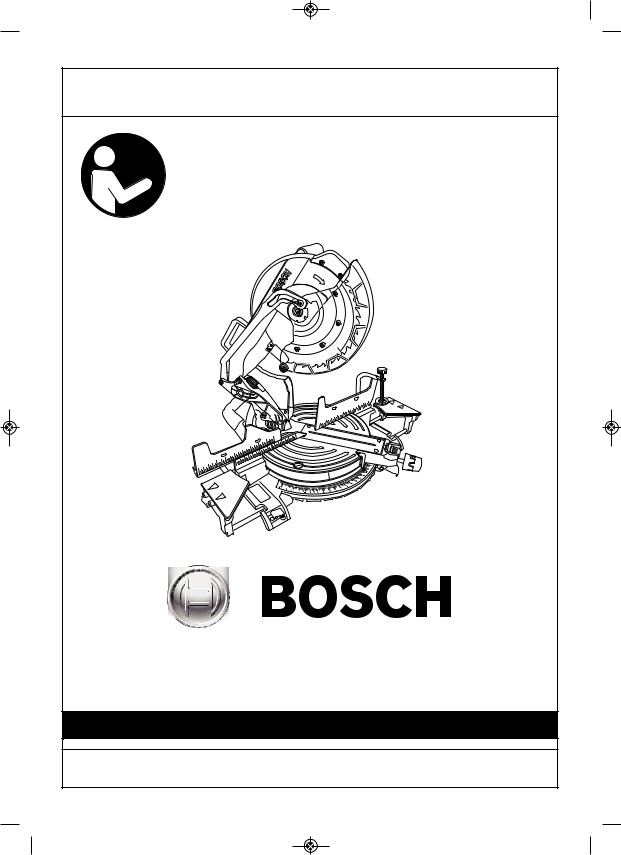
 BM 2610021316 10-11 E:BM 2610021316 10-11 E.qxp 10/17/11 11:02 AM Page 1
BM 2610021316 10-11 E:BM 2610021316 10-11 E.qxp 10/17/11 11:02 AM Page 1
IMPORTANT: |
IMPORTANT : |
IMPORTANTE: |
Read Before Using |
Lire avant usage |
Leer antes de usar |
|
|
|
Operating/Safety Instructions 
 Consignes de fonctionnement/sécurité
Consignes de fonctionnement/sécurité
Instrucciones de funcionamiento y seguridad
CM12
|
|
|
|
Call Toll Free for Con- |
Pour obtenir des informations |
Llame gratis para |
|
sumer Information |
et les adresses de nos centres |
obtener información |
|
& Service Locations |
de service après-vente, |
para el consumidor y |
|
|
|
appelez ce numéro gratuit |
ubicaciones de servicio |
1-877-BOSCH99 (1-877-267-2499) www.boschtools.com
For English Version |
Version française |
Versión en español |
See page 2 |
Voir page 38 |
Ver la página 74 |
|
|
|
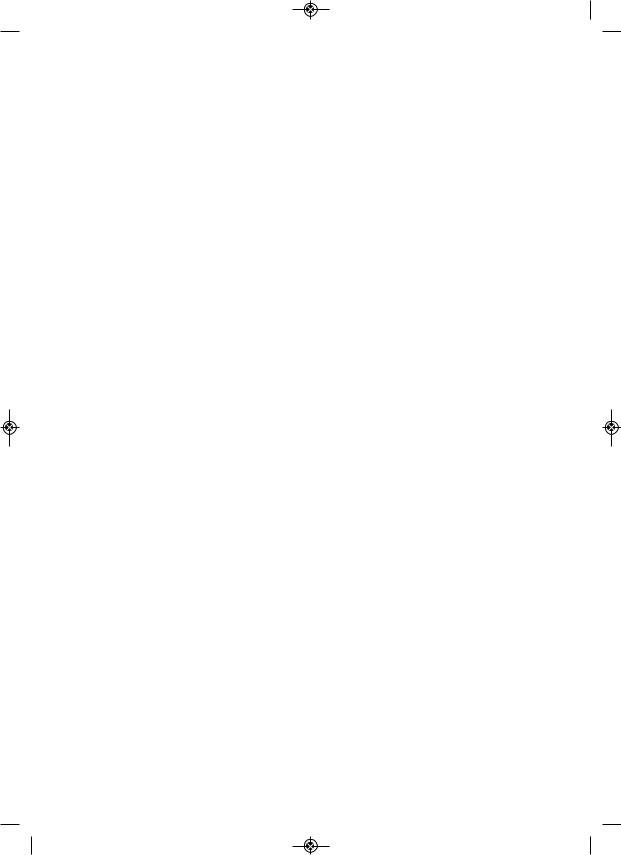
 BM 2610021316 10-11 E:BM 2610021316 10-11 E.qxp 10/17/11 11:02 AM Page 2
BM 2610021316 10-11 E:BM 2610021316 10-11 E.qxp 10/17/11 11:02 AM Page 2
|
Safety |
|
|
“READ ALL INSTRUCTIONS” — Failure to follow the SAFETY RULES identified by |
|
! WARNING |
||
|
BULLET (•) symbol listed BELOW and other safety precautions, may result in serious |
|
personal injury. |
||
|
||
|
General Safety Rules for Bench Top Tools |
Work Area
•Keep work area clean and well lit. Cluttered benches and dark areas invite accidents.
•Do not operate power tools in explosive atmospheres, such as in the presence of flammable liquids, gases or dust. Power tools create sparks which may ignite the dust or fumes.
•Keep bystanders, children and visitors away while operating a power tool. Distractions can cause you to lose control.
•Store idle tools out of reach of children and other untrained persons. Tools are dangerous in the hands of untrained users.
•Do not leave tool running unattended, turn power off. Do not leave tool until it comes to a complete stop.
•MAKE WORKSHOp CHIlDpROOf with pad lock, master switches, or by removing starter keys.
Electrical Safety
•Before plugging in the tool, be certain the outlet voltage supplied is compatible with the voltage marked on the nameplate within 10%.
An outlet voltage incompatible with that specified on the nameplate can result in serious hazards and damage to the tool.
•Double insulated tools are equipped with a polarized plug (one blade is wider than the other). This plug will fit in a polarized outlet only one way. If the plug does not fit fully in the outlet, reverse the plug. If it still does not fit, contact a qualified electrician to install a polarized outlet. Do not change the plug in any way. Double insulation eliminates the need for the three wire grounded power cord and grounded power supply.
•Avoid body contact with grounded surfaces such as pipes, radiators, ranges and refrigerators. There is an increased risk of electric shock if your body is grounded.
•Do not expose power tools to rain or wet conditions. Water entering a power tool will increase the risk of electric shock.
•Do not abuse the cord. Never use the cord to carry the tools or pull the plug from an outlet.
•Keep cord away from heat, oil, sharp edges or moving parts. Replace damaged cords immediately. Damaged cords increase the risk of electric shock.
•When operating a power tool outside, use an outdoor extension cord marked “W-A” or “W”.
These cords are rated for outdoor use and reduce the risk of electric shock.
personal Safety
•Stay alert, watch what you are doing and use common sense when operating a power tool.
A moment of inattention or use of drugs, alcohol or medication while operating power tools can be dangerous.
•Dress properly. Do not wear loose clothing or jewelry. Contain long hair. Keep your hair, clothing and gloves away from moving parts.
Loose clothes, jewelry or long hair can be caught in moving parts. Roll long sleeves above elbows. Rubber gloves and non-skid footwear are recommended when working outdoors.
•Avoid accidental starting. Be sure switch is “Off” before plugging in. Carrying tools with your finger on the switch or plugging in tools that have the switch “ON” invites accidents.
•Remove adjusting keys or wrenches before turning the tool “ON”. A wrench or a key that is left attached to a rotating part of the tool will be thrown.
•Do not overreach, keep proper footing and balance at all times. Proper footing and balance enables better control of the tool in unexpected situations.
•Do not stand on tool or its stand. Serious injury may occur if the tool is tipped or if the cutting tool is accidentally contacted. Do not store materials on or near the tool such that it is necessary to stand on the tool or its stand to reach them.
•Use safety equipment. Always wear safety goggles. Dust mask, safety shoes, hard hat or hearing protection must be used for appropriate conditions. Everyday eyeglasses only have impact resistant lenses, they are NOT safety glasses.
“SAVE THESE INSTRUCTIONS”
-2-
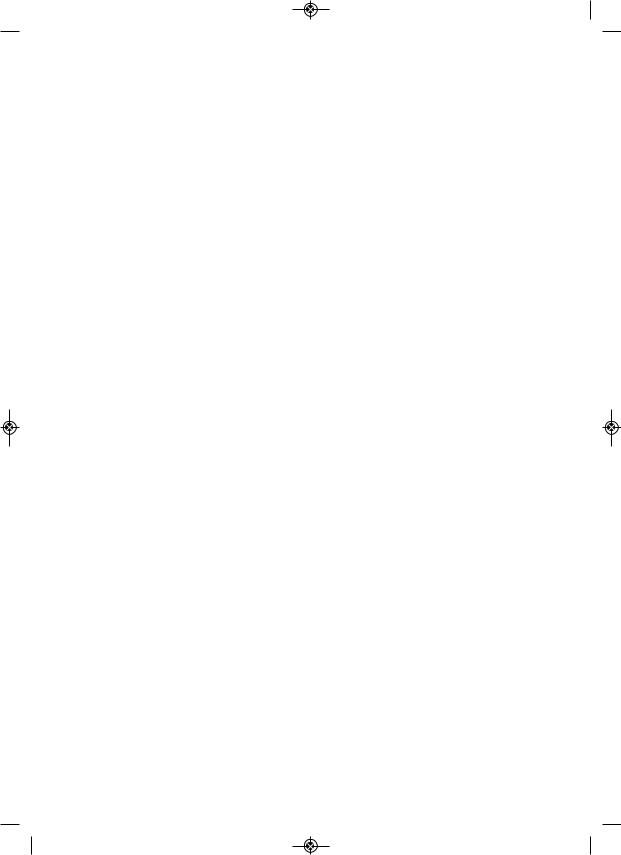
 BM 2610021316 10-11 E:BM 2610021316 10-11 E.qxp 10/17/11 11:02 AM Page 3
BM 2610021316 10-11 E:BM 2610021316 10-11 E.qxp 10/17/11 11:02 AM Page 3
|
Safety |
|
“READ ALL INSTRUCTIONS” — Failure to follow the SAFETY RULES identified by |
! WARNING |
|
|
BULLET (•) symbol listed BELOW and other safety precautions, may result in serious |
|
personal injury.
Tool Use and Care
•Use clamps or other practical way to secure and support the workpiece to a stable platform. Holding the work by hand or against your body is unstable. It allows for work to shift, causes binding of the tool and loss of control.
•Do not force tool. Use the correct tool for your application. The correct tool will do the job better and safer at the rate for which it is designed. Do not use the tool for purpose not intended - for example; do not use the miter saw for slicing meats.
•Do not use tool if switch does not turn it “ON” or “Off”. Any tool that cannot be controlled with the switch is dangerous.
•Disconnect the plug from the power source before making any adjustments or changing accessories. Such preventive safety measures reduce the risk of starting the tool accidentally.
•Keep cutting tools sharp and clean. Properly maintained tools, with sharp cutting edges, are less likely to bind and easier to control. When mounting saw blades be certain that the arrow on the blade matches the direction of the arrow marked on the tool and that the teeth are also pointing in the same direction.
•Inspect guards before using a tool. Keep guards in place. Check moving parts for binding or any other condition that may affect the normal operation or safety features of the tool. If damaged, have tool serviced before using the tool. Many accidents are caused by poorly maintained tools.
•Do not alter or misuse tool. Any alteration or modification is a misuse and may result in serious personal injury.
•The use of any other accessories not specified in this manual may create a hazard.
Accessories that may be suitable for one type of tool, may become hazardous when used on an inappropriate tool.
Service
•Tool service must be performed only by qualified repair personnel. Service or maintenance performed by unqualified personnel may result in misplacing internal wires and components which could cause serious hazard.
•When servicing a tool, use only identical replacement parts. follow instructions in the Maintenance section of this manual. Use of unauthorized parts or failure to follow Maintenance Instructions may create a hazard.
Safety Rules for Miter Saws
•To reduce risk of injury, use saw blade rated 4300/min (RpM) or greater.
•Use clamps to support workpiece whenever possible. If supporting the workpiece by hand,
you must always keep hand outside of “No Hand” area as marked with a symbol on the base. Do not use this saw to cut pieces that are too small to be securely clamped. Your hand if placed inside the “No Hands” region can easily slip or be pulled into the blade.
•Do not reach in back of the saw blade behind the fence with either hand to hold
down or support the workpiece, remove wood scraps, or for any other reason. The proximity of the spinning saw blade to your hand may not be obvious and you may be seriously injured.
•Never cross your hand over intended line of cutting. Supporting the workpiece “cross handed” i.e. holding the left side of the workpiece with your right hand is very dangerous.
•Always disconnect the power cord from the power source before making any adjustments or attaching any accessories. You may unintentionally start the saw, leading to serious personal injury.
•Miter saws are intended to cut wood or woodlike products, they cannot be used with abrasive cutoff wheels for cutting ferrous material such as bars, rods, studs, etc. However, if cutting materials like aluminum or other non-ferrous metals, use only saw blades specifically recommended for non ferrous metal cutting. Cutting ferrous materials causes excessive sparking and will damage the lower guard and will overload the motor.
•Inspect your workpiece before cutting. If workpiece is bowed or warped, clamp it with the outside bowed face toward the fence. Always make certain that there is no gap be-tween the workpiece, fence and table along
“SAVE THESE INSTRUCTIONS”
-3-
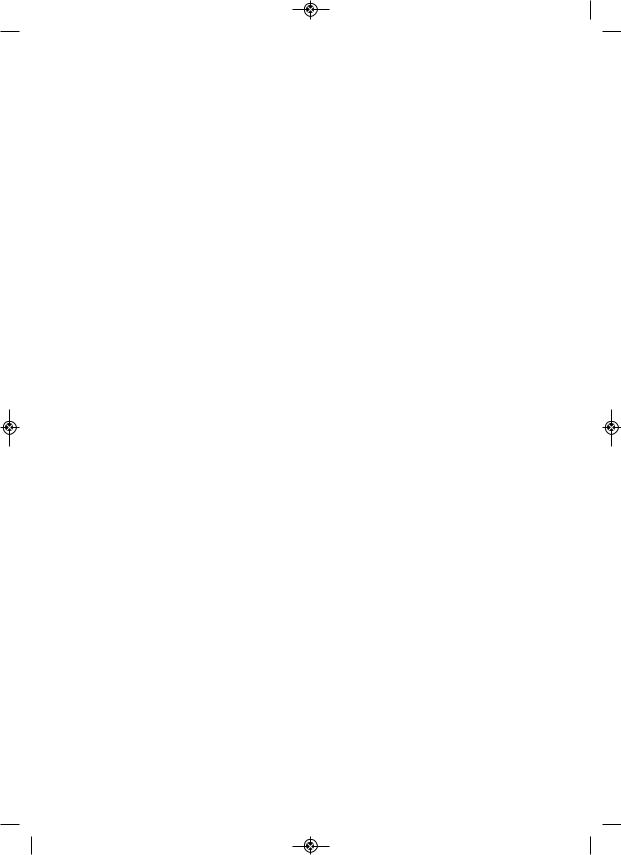
 BM 2610021316 10-11 E:BM 2610021316 10-11 E.qxp 10/17/11 11:02 AM Page 4
BM 2610021316 10-11 E:BM 2610021316 10-11 E.qxp 10/17/11 11:02 AM Page 4
|
Safety |
|
“READ ALL INSTRUCTIONS” — Failure to follow the SAFETY RULES identified by |
! WARNING |
|
|
BULLET (•) symbol listed BELOW and other safety precautions, may result in serious |
|
personal injury.
the line of the cut. Bent or warped workpieces can twist or rock and may cause binding on the spinning saw blade while cutting. Also, make sure there are no nails or foreign objects in the workpiece.
•Do not use the saw until the table is clear of all tools, wood scraps, etc., except the workpiece. Small debris or loose pieces of wood or other objects that contact the revolving blade can be thrown with high speed at the operator.
•Do not feed workpiece into the blade or cut “freehand” in any way. Workpiece must be stationary and clamped or braced by your hand. Saw must be fed through the workpiece smoothly and at a rate which will not overload the saw’s motor.
•Cut only one workpiece at a time. Multiple workpieces cannot be adequately clamped or braced and may bind on the blade or shift during cutting.
•Be certain the miter saw is mounted or placed on a level, firm work surface before using. A level and firm work surface reduces the risk of the miter saw becoming unstable.
•plan your work. provide adequate support accessories such as tables, saw horses, table extension, etc. for workpieces wider or longer than the table top (see page 21). Workpieces longer or wider than the miter saw table can tip if not securely supported. If the cutoff piece or workpiece tips it can lift the lower guard or be thrown by the spinning blade.
•Do not use another person as a substitute for a table extension or as additional support.
Unstable support for the workpiece can cause the blade to bind or the workpiece to shift
during the cutting operation pulling you and the helper into the spinning blade.
•The cutoff piece must not be jammed against or pressured by any other means against the spinning saw blade. If confined, i.e. using length stops, it could get wedged against the blade and thrown violently.
•Always use a clamp or a fixture designed to properly support round material such as
dowel rods, or tubing. Rods have a tendency to roll while being cut, causing the blade to “bite” and pull the work with your hand into the blade.
•When cutting irregularly shaped workpieces, plan your work so it will not slip and pinch the blade and be torn from your hand.
A piece of molding, for example, must lie flat or be held by a fixture or jig that will not let it twist, rock or slip while being cut.
•let the blade reach full speed before contacting the workpiece. This will help avoid thrown workpieces.
•If the workpiece or blade becomes jammed or bogged down, turn miter saw “Off” by releasing switch. Wait for all moving parts to stop and unplug the miter saw, then work to free the jammed material. Continued sawing with jammed workpiece could cause loss of control or damage to miter saw.
•Braking action of the saw causes the saw head to jerk downward. Be ready for this reaction when making an incomplete cut or when releasing the switch before the head is completely in the down position.
•After finishing the cut, release the switch, hold the saw arm down and wait for blade to stop before removing work or cutoff piece. If blade does not stop within five (5) seconds, unplug the saw and follow the instructions in the Troubleshooting section. REACHING WITH YOUR HAND UNDER A COASTING BLADE IS DANGEROUS!
•There are additional safety instructions for particular operations of the saw in the operating section. Read the rest of the manual for safe operation.
•for chop action cutting, turn the saw “ON” and lower the head assembly to make the cut. Release the switch and wait for the blade to completely stop before raising the head assembly and removing the workpiece.
•Do not allow familiarity gained from frequent use of your miter saw to become commonplace. Always remember that a careless fraction of a second is sufficient to inflict severe injury.
“SAVE THESE INSTRUCTIONS”
-4-
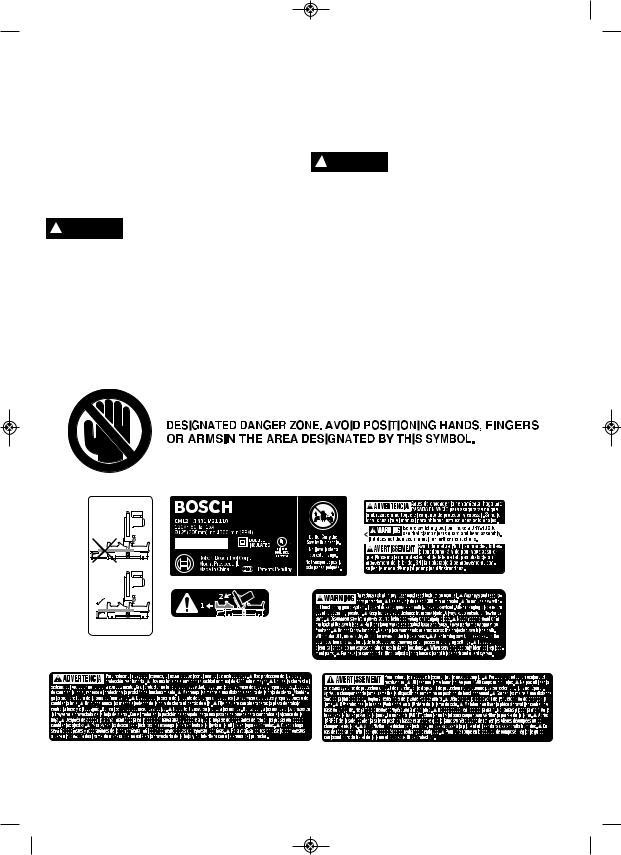
 BM 2610021316 10-11 E:BM 2610021316 10-11 E.qxp 10/17/11 11:02 AM Page 5
BM 2610021316 10-11 E:BM 2610021316 10-11 E.qxp 10/17/11 11:02 AM Page 5
|
Safety |
|
|
“READ ALL INSTRUCTIONS” — Failure to follow the SAFETY RULES identified by |
|
! WARNING |
||
|
BULLET (•) symbol listed BELOW and other safety precautions, may result in serious per- |
|
sonal injury. |
||
|
•THINK SAFETY! SAFETY IS A COMBINATION OF OPERATOR’S COMMON SENSE, KNOWLEDGE OF THE SAFETY AND OPERATING INSTRUCTIONS AND ALERTNESS AT ALL TIMES WHEN THE MITER SAW IS BEING USED.
THE WARNINGS SHOWN
BElOW CAN BE fOUND ON YOUR TOOl. THESE WARNINGS ARE ONlY A CONDENSED fORM Of THE MORE DETAIlED SAfETY RUlES AND pRECAUTIONS THAT AppEAR IN YOUR OWNER'S MANUAl. THEY SERVE AS A REMINDER Of All SAfETY RUlES NEEDED fOR SAfE OpERATION Of THIS MITER SAW.
! WARNING Some dust created by power sanding, sawing, grinding,
drilling, and other construction activities contains chemicals known to cause cancer, birth defects or other reproductive harm. Some examples of these chemicals are:
•Lead from lead-based paints,
•Crystalline silica from bricks and cement and other masonry products, and
•Arsenic and chromium from chemically treated lumber.
Your risk from these exposures varies, depending on how often you do this type of work. To reduce your exposure to these chemicals: work in a well ventilated area, and work with approved safety equipment, such as those dust masks that are specially designed to filter out microscopic particles.
“SAVE THESE INSTRUCTIONS”
-5-
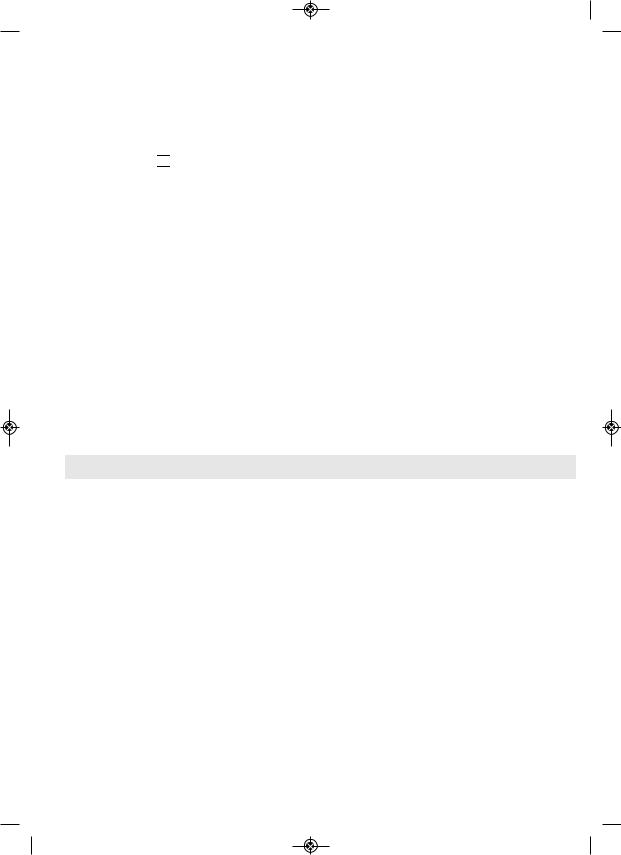
 BM 2610021316 10-11 E:BM 2610021316 10-11 E.qxp 10/17/11 11:02 AM Page 6
BM 2610021316 10-11 E:BM 2610021316 10-11 E.qxp 10/17/11 11:02 AM Page 6
|
Safety |
|
“READ ALL INSTRUCTIONS” — Failure to follow the SAFETY RULES identified by |
! WARNING |
|
|
BULLET (•) symbol listed BELOW and other safety precautions, may result in serious |
|
personal injury.
Double Insulated Tools
Double insulation 


 is a design concept used in electric power tools which eliminates the need for the three wire grounded power cord and grounded power supply system. It is a recognized and approved system by Underwriter’s Laboratories, CSA and Federal OSHA authorities.
is a design concept used in electric power tools which eliminates the need for the three wire grounded power cord and grounded power supply system. It is a recognized and approved system by Underwriter’s Laboratories, CSA and Federal OSHA authorities.
•Servicing of a tool with double insulation requires care and knowledge of the system and should be performed only by a qualified service technician.
•WHEN SERVICING, USE ONLY IDENTICAL REPLACEMENT PARTS.
•POLARIZED PLUGS. To reduce the risk of electrical shock, your tool is equipped with a polarized plug (one blade is wider than the other), this plug will fit in a polarized outlet only one way. If the plug does not fit fully in the outlet, reverse the plug. If it still does not fit, contact a qualified electrician to install the proper outlet. To reduce the risk of electrical shock, do not change the plug in any way.
Extension Cords
•Replace damaged cords immediately. Use of damaged cords can shock, burn or electrocute.
•If an extension cord is necessary, a cord with adequate size conductors should be used to prevent excessive voltage drop, loss of power or overheating. The table shows the correct size to use, depending on cord length and nameplate amperage rating of tool. If in doubt, use the next heavier gauge. Always use U.L. and CSA listed extension cords.
RECOMMENDED SIZES Of EXTENSION CORDS
Tool’s |
Cord Size in A.W.G. |
Wire Sizes in mm2 |
|||||||
Ampere |
Cord length in feet |
Cord length in Meters |
|||||||
Rating |
25 |
50 |
100 |
150 |
15 |
30 |
60 |
120 |
|
3-6 |
|
18 |
16 |
16 |
14 |
0.75 |
0.75 |
1.5 |
2.5 |
6-8 |
|
18 |
16 |
14 |
12 |
0.75 |
1.0 |
2.5 |
4.0 |
8-10 |
|
18 |
16 |
14 |
12 |
0.75 |
1.0 |
2.5 |
4.0 |
10-12 |
|
16 |
16 |
14 |
12 |
1.0 |
2.5 |
4.0 |
— |
12-16 |
|
14 |
12 |
— |
— |
— |
— |
— |
— |
NOTE: The smaller the gauge number, the heavier the cord.
“SAVE THESE INSTRUCTIONS”
Table of Contents
Safety . . . . . . . . . . . . . . . . . . . . . . . . . . . . . |
.2-6 |
General Safety Rules For Bench Top Tools |
.2-3 |
Safety Rules For Miter Saws . . . . . . . . . . . |
.3-5 |
Table of Contents . . . . . . . . . . . . . . . . . . . |
.6 |
Electrical Requirements . . . . . . . . . . . . . . |
.7 |
Getting To Know Your Miter Saw . . . . . . |
.7-9 |
Unpacking and Checking Contents . . . . .10 |
|
Assembly . . . . . . . . . . . . . . . . . . . . . . . . . . |
.10-13 |
Tools Needed for Assembly and Alignment |
.10 |
Removing and installing Blades . . . . . . . . . |
.10-12 |
Assembling Dust Elbow and Dust Bag . . . . |
.12 |
Attaching Miter Lock Knob . . . . . . . . . . . . . |
.13 |
Adjustments . . . . . . . . . . . . . . . . . . . . . . . . |
.13-16 |
Checking 0° Bevel Adjustment . . . . . . . . . . |
.13 |
Checking Left 45° Bevel Adjustment . . . . . . |
.14 |
Adjusting Bevel Scale Pointer . . . . . . . . . . . |
.15 |
Calibrating Miter Detent System . . . . . . . . . |
.15 |
Miter Scale Pointer Adjustment . . . . . . . . . . |
.15 |
Kerf Insert Adjustment . . . . . . . . . . . . . . . . . |
.16 |
Transporting and Mounting . . . . . . . . . . |
.16-17 |
Preparing to Lift the Saw . . . . . . . . . . . . . . . |
.16 |
Lift the Saw by Rear Carry Handle . . . . . . . |
.17 |
Lift the Saw by the Cast-In Carry Handles . .17 placement and Mounting . . . . . . . . . . . . .17-18 Workbench Permanent Attachment . . . . . .17 Alternate Attachment . . . . . . . . . . . . . . . . .18 Basic Saw Operations . . . . . . . . . . . . . . .18-19 Switch Activation . . . . . . . . . . . . . . . . . . . .18 Body and Hand Position . . . . . . . . . . . . . . .19 preparing for Saw Operations . . . . . . . .20 Workpiece Support . . . . . . . . . . . . . . . . . . .20 Operating Sliding Fence . . . . . . . . . . . . . . .20 Removing Sliding Fence . . . . . . . . . . . . . .20 Basic Saw Operations . . . . . . . . . . . . . . .21-25 Adjusting Sliding Fence Lock Lever . . . . . .21 Long Workpiece Support . . . . . . . . . . . . . .21 Additional Workpiece Support . . . . . . . . . .21 Using Miter Detent System . . . . . . . . . . . .22 Miter Detent Override . . . . . . . . . . . . . . . . .23 Chop Cut . . . . . . . . . . . . . . . . . . . . . . . . . .23 Miter Cut . . . . . . . . . . . . . . . . . . . . . . . . . . .24 Bevel Cut . . . . . . . . . . . . . . . . . . . . . . . . . .24 Compound Cuts . . . . . . . . . . . . . . . . . . . . .25 Cutting Base Molding . . . . . . . . . . . . . . . . .26
-6-
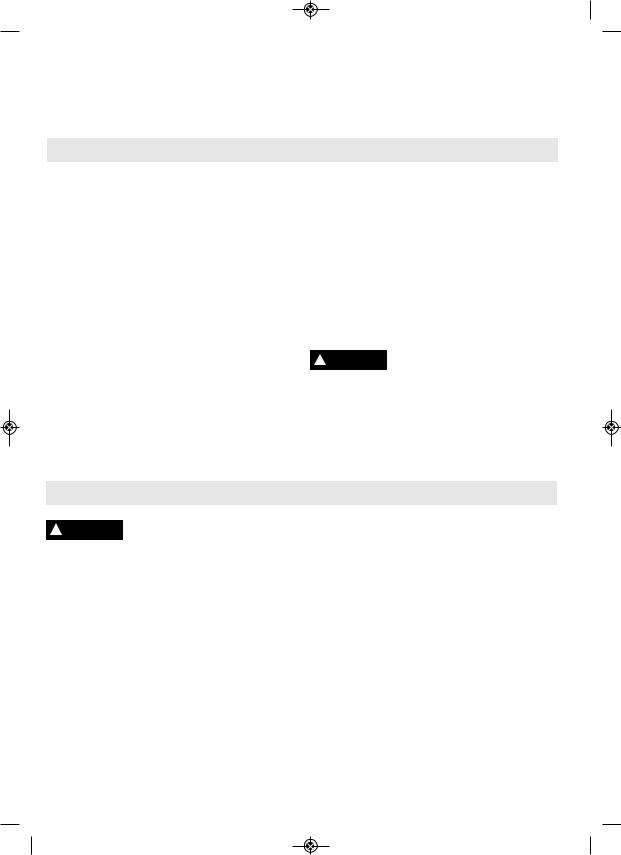
 BM 2610021316 10-11 E:BM 2610021316 10-11 E.qxp 10/17/11 11:02 AM Page 7
BM 2610021316 10-11 E:BM 2610021316 10-11 E.qxp 10/17/11 11:02 AM Page 7
Cutting Crown Molding . . . . . . . . . . . . . . . |
.26-32 |
Troubleshooting . . . . . . . . . . . . . . . . . . . . |
35-36 |
Special Cuts . . . . . . . . . . . . . . . . . . . . . . . . |
32 |
Accessories . . . . . . . . . . . . . . . . . . . . . . . |
37 |
Maintenance and lubrication . . . . . . . . . |
33-34 |
|
|
Electrical Requirements
•Connect this saw to a 120V, 15-amp branch circuit with a 15-amp fuse or circuit breaker. Using the wrong size fuse can damage the motor.
•Fuses may “blow” or circuit breakers may trip frequently if motor is overloaded. Overloading can occur if you feed the blade into the workpiece too rapidly or start and stop too often in a short time.
•Most motor troubles may be traced to loose or incorrect connections, overload, low voltage (such as small size wire in the supply circuit or too overly long supply circuit wire). Always check the connections, the load and the supply circuit whenever motor does not work well.
Electric Brake
Your saw is equipped with an automatic electric brake which is designed to stop the blade from spinning in about five (5) seconds after you release the trigger switch.
|
When electrical power is lost due |
! WARNING |
|
|
to blown fuse or other causes, |
|
the motor will gradually slow down. The braking action is initiated ONlY by the release of the trigger switch.
The electric blade brake of your miter saw has been designed for highest degree of reliability, but unexpected circumstances such as contamination on the commutator and brushes or failure of motor’s components can cause the brake not to activate. If this condition occurs, turn the saw “ON” and “OFF” four to five times without contacting the workpiece. If the tool operates but the brake does not consistently stop the blade in about five (5) seconds, DO NOT use saw and have it serviced immediately.
The brake action of this saw is not intended as a safety feature.
Remember to let the saw blade come to a complete stop before raising the blade from the workpiece. As always the guard system is your best protection against unintentional contact with a spinning saw blade. NEVER wedge open or defeat the closing action of the lower guard.
Getting To Know Your Miter Saw (See page 8 & 9)
To avoid injury from accidental starting, remove plug from power
source outlet before making any adjustments.
1.Rear One-handed Carry Handle – This handle is positioned for optimal one-handed carrying.
2.Top Carry Handle – This handle is built into the head assembly for transportation.
3.Switch lock-Off Toggle – The toggle needs to be moved left or right before the power switch can be pressed.
4.power Switch – The power switch used with the Lock-OFF Toggle energizes the unit.
5.Switch Handle – The power switch used with the ambidextrous toggle energizes the saw.
6.lower Blade Guard/lower Blade Guard lip –
The lower blade guard helps protect your hands from the spinning blade. It retracts as the blade is lowered. Lip can be used to raise the lower guard
when guard becomes jammed on a workpiece.
7.Blade – Use only 12” (305 mm) blades with 1” (25.4 mm) arbor hole.
8.Blade Wrench/Storage – Used in blade change process; tightening and loosening blade and blade guard.
9.Chip Deflector – This protects against large chips from entering the upper guard.
10.Upper Blade Guard – Covers upper portion of the blade.
11.Sliding fence – Supports the workpiece and features cast-in scales for repetitive cuts and holes to secure an auxiliary fence. Slide left side out prior to beveling head left. Right side is stationary.
12.Stationary fence – Stationary fence is bolted to the base and will support the workpiece when the sliding fence is removed. (Note the right side does not slide or remove.)
-7-
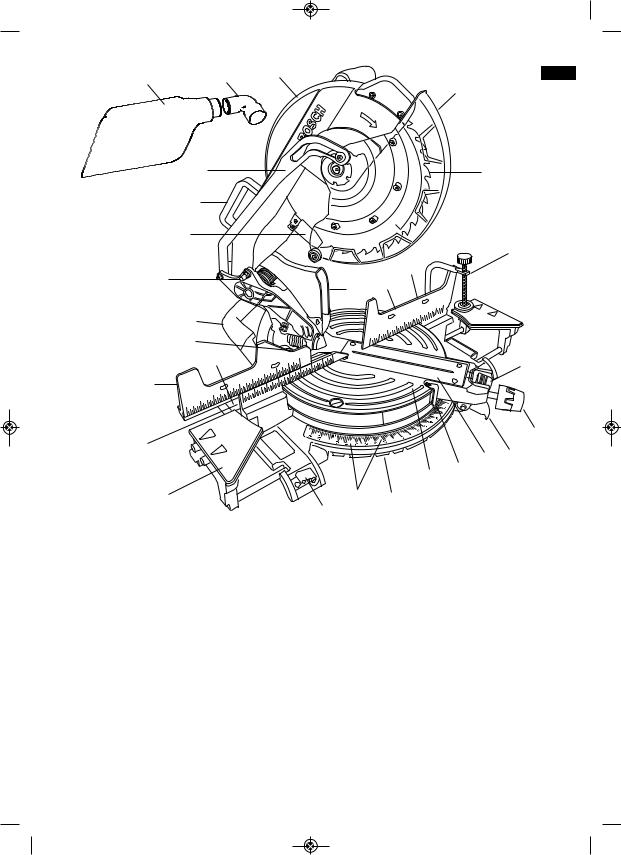
 BM 2610021316 10-11 E:BM 2610021316 10-11 E.qxp 10/17/11 11:02 AM Page 8
BM 2610021316 10-11 E:BM 2610021316 10-11 E.qxp 10/17/11 11:02 AM Page 8
26 |
25 |
10 |
FIG. 1 |
|
6 |
||
|
|
|
27 |
|
|
7 |
2 |
|
|
|
9 |
|
|
|
|
|
|
28 |
36 |
|
|
29 |
|
24 |
12 |
|
|
|
||
|
|
|
|
1 |
|
|
|
33 |
|
|
|
|
8 |
|
14 |
|
|
|
11
15
12
13 16
|
|
20 |
17 |
21 |
19 |
18 |
|
|
22 |
|
|
13.Kerf Insert – Kerf inserts can be adjusted to different blade widths to minimize workpiece tear out.
14.Miter Detent Override – Allows detent action to be locked out allowing for adjustments to any miter angle.
15.Miter lock Knob – The miter lock knob locks the miter saw table at any desired miter angle.
16.Miter Detent lever – The lever releases the table from the detent.
17.Miter Scale/Miter pointer – The pointer rotates with the table and blade. It points to the miter scale to indicate the angle setting before a cut is made.
18.Miter Detents plate – There are ten (10) miter detent slots for fast and accurate miter cuts of common angles. The position of the plate can be adjusted to set the accuracy of its detent locations.
19.Miter Detent plate Screws – Four screws accessible through holes in the miter scale. The screws are loosened when adjusting detent plate position.
20.Table – Sits in base, provides workpiece support, rotates for desired miter cuts and rotates the head assembly.
21.Sliding Base Extensions – Provides working surface to support workpiece, expands to support longer materials.
22.Base Extension Clamping levers – Lock the base extensions at the desired positions.
23.Tool Mounting pads – The four corners of the saw provide areas to clamp, bolt or nail/screw the saw to a flat work surface.
24.Dust Chute – Directs sawdust up and through elbow to the dust bag.
-8-
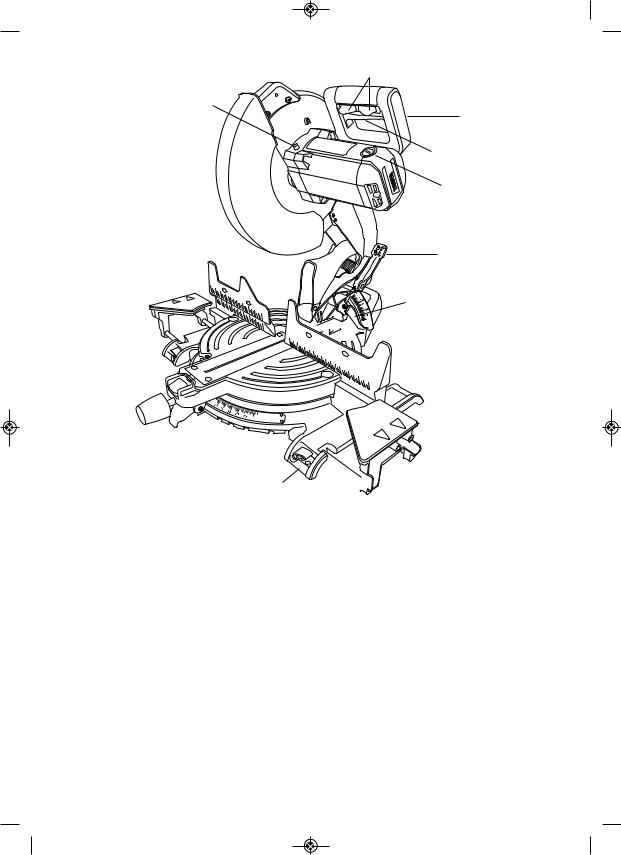
 BM 2610021316 10-11 E:BM 2610021316 10-11 E.qxp 10/17/11 11:02 AM Page 9
BM 2610021316 10-11 E:BM 2610021316 10-11 E.qxp 10/17/11 11:02 AM Page 9
3 |
FIG. 2 |
35
5
4
30
31
32





 34
34
23
25.Dust Elbow – Connects the dust chute to the 31. Bevel lock lever – Locks and unlocks the
dust bag. Can be rotated to direct dust.
26.Dust Bag – Captures chips and dust. Has zipper at the bottom. Bag can be uncoupled from elbow or chute for emptying.
27.lower Guard Actuation link –Allows for smooth movement of the lower guard.
28.Material Clamp – Used to hold the workpiece to the table and base; insert into clamp post location (item 29).
29.Clamp post location – Insert material clamp post into hole prior to locking.
30.Brush Caps – Keeps motor brushes in position and provides easy access for inspecting and replacing brushes.
head assembly at a desired bevel angle.
32.Bevel Scale and pointers – Allows user to easily read bevel angles. Pointer indicates current angle.
33.left Bevel Stops – Adjust for 47°, 45°, and 33.9° bevel stops (crown molding setting).
34.-2° Right Bevel Stop – Slide front or back for 0° or -2° bevel stop to right.
35.Arbor lock – Press arbor lock button to keep blade from rotating when loosening or tightening arbor bolt during blade removal or installation.
36.Head Assembly lock pin – Used to lock the head assembly in lower position for transporting.
-9-
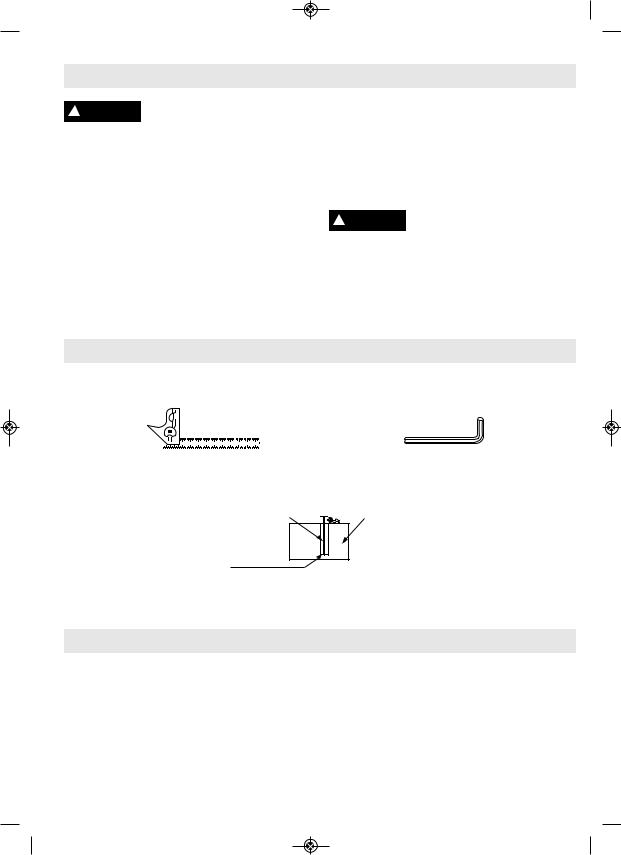
 BM 2610021316 10-11 E:BM 2610021316 10-11 E.qxp 10/17/11 11:02 AM Page 10
BM 2610021316 10-11 E:BM 2610021316 10-11 E.qxp 10/17/11 11:02 AM Page 10
Unpacking And Checking Contents
! WARNING Before moving the saw: lock the miter lock knob in 45° posi-
tion. lock head assembly in the down position.
Never carry the tool by the cord or head assembly power switch handle.
The CM12 Miter Saw is shipped complete in one box.
1.Separate all parts from packing materials and check each one with the “Table of Loose Parts” to make sure all items are accounted for before discarding any packing material.
2. Table of Loose Parts:
Workpiece Clamp - Used to clamp workpieces.
Dust Elbow/Dust Bag - Used to collect saw dust.
Multi purpose “L” wrench - Should be stored on the left rear base.
Miter Lock Knob - Used to lock the table at desired miter angle.
If any parts are missing, do not ! WARNING plug in power cord or turn the
switch on until the missing parts are obtained and are installed correctly.
Assembly
Tools Needed for Assembly And Alignment
|
Combination Square |
Multi Purpose “L” Wrench 6/4mm |
||||||||||||||||||||||||
|
|
|
|
|
|
|
|
|
|
|
|
|
|
|
|
|
|
|
|
|
|
|
|
|
|
|
Combination Square Must be True
Draw Light
Line on Board
Along this Edge
Should be no Gap or Overlap when Square is Flipped Over in Dotted Position
Straight Edge of Board 3/4" Thick This Edge Must be 
 Perfectly Straight
Perfectly Straight
Assembly
Removing and Installing Blades
|
! WARNING |
To avoid possible injury discon- |
Moving Guard Assembly |
|
|
nect plug form power source |
1. Position the saw in the UP position and at 0° |
|
|
||
before performing any assembly, adjustment or |
bevel. If in the DOWN position, press down slightly |
||
repairs. |
|
on the saw head assembly and pull out the head as- |
|
|
|
|
sembly lock pin (item 36, page 8); then allow the saw |
|
|
|
head to come up (See Figure 3). |
-10-
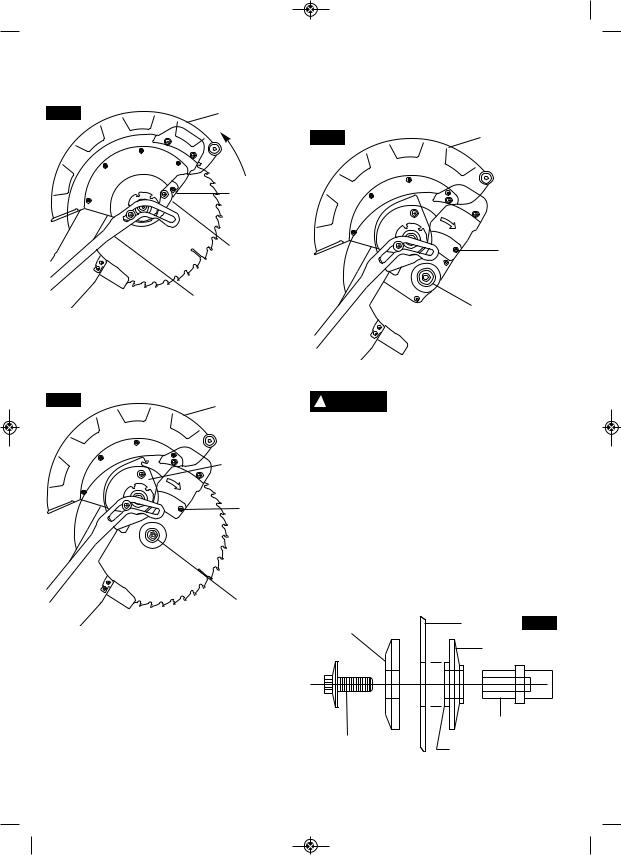
 BM 2610021316 10-11 E:BM 2610021316 10-11 E.qxp 10/17/11 11:02 AM Page 11
BM 2610021316 10-11 E:BM 2610021316 10-11 E.qxp 10/17/11 11:02 AM Page 11
2. Remove the blade wrench and raise the lower guard to its highest point, exposing the forward cover plate screw. (see Figure 3)
FIG. 3 |
lower Guard |
3. Remove the blade bolt and outer washer. Carefully grab the blade. Slide the blade away from the inner washer and off the arbor shaft, then down and away from the saw. Leave the inner washer on the arbor shaft. (see Figure 5)
FIG. 5 |
lower Guard |
forward Cover plate Screw
Cover plate
Guard link
3. Loosen the forward cover plate screw with the
4 mm portion of the blade wrench approximately four rotations. This will allow the cover plate to rotate 30° upward and expose the arbor shaft and bolt. The guard will hold itself in place while blade changes are made. (see Figure 4)
FIG. 4 |
lower Guard |
|
|
|
Cover plate |
|
forward |
|
Cover plate |
|
Screw |
BladeBolt/
Outer Washer
Removing Blade
1. Press and hold the arbor lock (red button on opposite side of upper guard – item 35, page 9).
Rotate the blade slowly while pressing the arbor lock until it fully seats into its lock position.
2. Using the 6/4mm hex key, loosen the blade bolt by firmly turning it clockwise. NOTE: This bolt has left-hand threads.
forward Cover plate
Inner Blade
Washer
Installing 12" Blade
! WARNING To avoid injury, do not use a blade larger or smaller than 12"
diameter and 1" arbor. The blade’s maximum plate thickness is 0.100".
! WARNING |
To reduce risk of injury, use saw |
|
|
blade rated 4300/min (RpM) or |
|
greater. |
||
|
1.Follow all “Moving Guard Assembly” and “Removing Blade” steps.
2.Carefully handle the new blade. Check that the rotation arrow on the blade matches the rotation arrow on the upper guard (see Figure 5). Slide the blade up and between the sides of the chip deflector and over the arbor shaft. Move the blade so its arbor hole goes around the support ring of the inner washer. (See Figure 6).
Outer Washer |
Sawblade FIG. 6 |
|
Inner Washer |
|
Arbor Shaft |
Blade Bolt |
Support Ring |
|
-11-
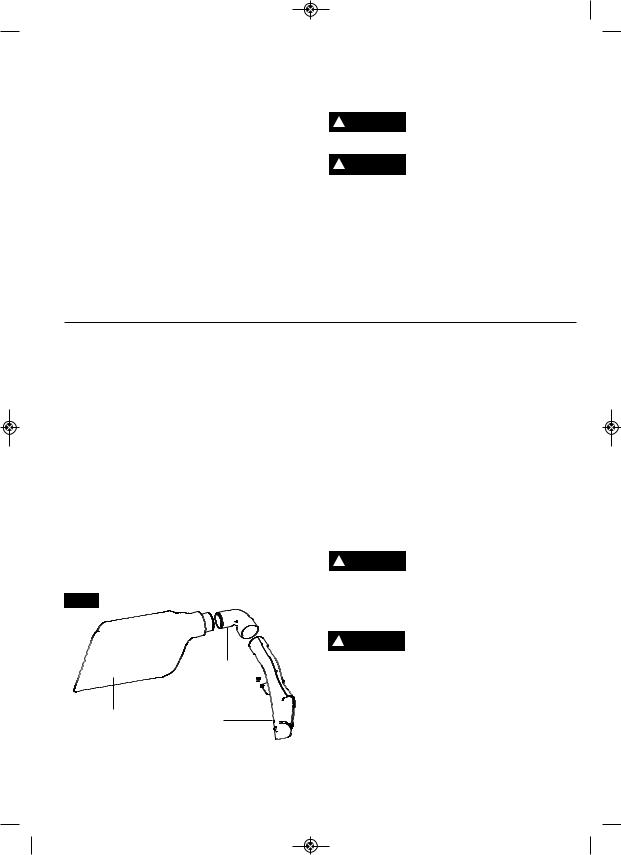
 BM 2610021316 10-11 E:BM 2610021316 10-11 E.qxp 10/17/11 11:02 AM Page 12
BM 2610021316 10-11 E:BM 2610021316 10-11 E.qxp 10/17/11 11:02 AM Page 12
3.Place the outer washer over the arbor shaft and finger-tighten the blade bolt (counterclockwise). Check that the blade remained on the inner washer’s support ring.
4.Rotate the blade slowly while pressing the arbor lock until it fully seats into its lock position.
8.Be sure the arbor lock is released so the blade turns freely.
9.Place the 6/4mm hex key back in storage area.
! WARNING Never use saw without cover plate securely in place. Lower
guard will not function properly.
5.Using the 6/4mm hex key, firmly tighten the blade bolt counterclockwise. NOTE: This bolt has lefthand threads. Do not over tighten. A 6mm hex key may be used as an alternate.
6.Slowly rotate the upper guard down and the cover plate will also rotate until it seats on top of the forward cover plate screw.
7.Once in place, rotate the upper guard back up and it will expose the forward cover plate screw. (See Figure 3) Tighten the screw and release the lower guard
After installing a new blade, make sure the blade does not interfere with the table insert at 0° and 45° bevel
positions. lower the blade into the blade slot and check for any contact with the base or turntable structure. If the blade contacts base or table, seek authorized service.
Assembling Dust Elbow And Dust Bag
Assembling Dust Elbow and Dust Bag
The dust collection system used on this tool is unique because it is not attached to the upper guard. This placement provides superior dust collection for the majority of cuts.
Elbow
The CM12 offers two dust chute configurations, either with or without the dust elbow.
Use the dust elbow when working in tight locations or up against a wall where space is limited behind the saw. For optimal dust collection, set the dust elbow aside and connect the dust bag directly to the dust chute.
To attach the dust elbow, slide the elbow onto the dust chute for a pressure fit (Fig. 7).
FIG. 7
Elbow
Dust |
Dust |
Chute |
Chute |
Direct the elbow in any direction preferred based on your tool setup and location.
Attach Dust Bag
To attach the dust bag, slide the bag onto the dust chute or the elbow for a pressure fit. (See Figure 7)
Cleaning Dust Bag
After the dust bag is 2/3 to 3/4 full, remove it form the saw. Bring the bag to a proper container and pull open the zipper located on the bottom of the bag. Hold the bag by the coupler end and shake it vigorously until all the dust and debris fall from it. Close zipper and reattach the bag to the saw.
Be extremely careful when dis- ! WARNING posing of dust. Do not throw
sawdust on an open fire. Materials in fine particle form may be explosive. Spontaneous combustion, in time, may result from the mixture of oil or water with dust particles.
When sawing chemically pressure treated lumber, paint that may be lead based, or any other materials that
may contain carcinogens, use special precautions. A suitable respirator must be worn by all personnel entering the work area. Work area should be sealed by plastic sheeting and persons not protected should be kept out until work area is thoroughly cleaned.
-12-
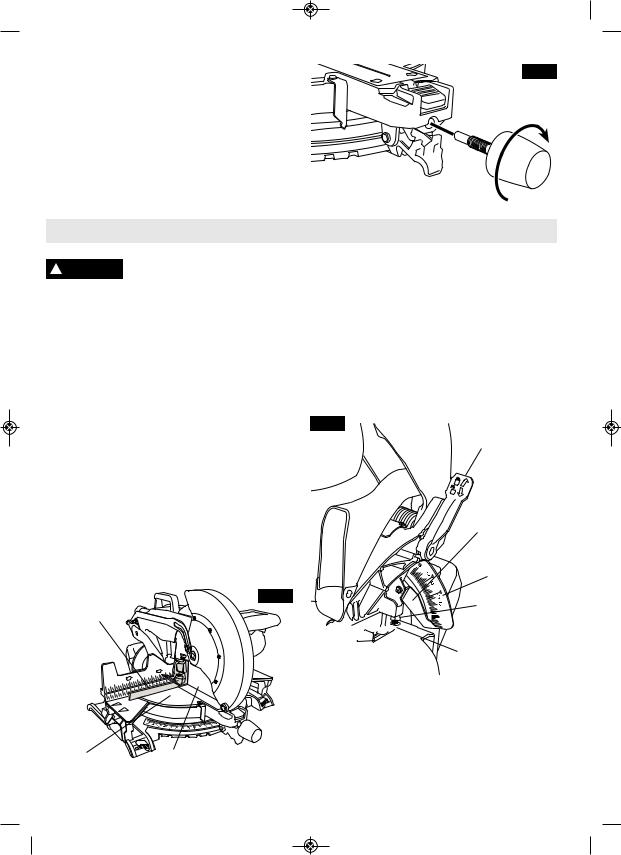
 BM 2610021316 10-11 E:BM 2610021316 10-11 E.qxp 10/17/11 11:02 AM Page 13
BM 2610021316 10-11 E:BM 2610021316 10-11 E.qxp 10/17/11 11:02 AM Page 13
Attaching Miter lock Knob |
FIG. 8 |
Locate the miter gauge lock knob from among the loose parts, and thread shaft on lock knob into hole provided. (See Figure 8)
Adjustments
! WARNING Disconnect plug from power source before performing any
assembly, adjustment or repair to avoid possible injury.
NOTE: Your miter saw was completely adjusted at the factory. However, during shipment, slight misalignment may have occurred. Check the following settings and adjust if necessary prior to using this miter saw.
Checking 0° Bevel Adjustment
1.Lower head assembly and engage head assembly lock pin.
2.Rotate table to 0° miter position and lock.
3.Pull forward bevel lock lever to unlock bevel.
4.Tilt the saw assembly to the left, then rotate saw assembly to the right until you feel the stop in the vertical position. This is where the saw is currently set for 0° bevel cut.
5.Use a combination square to check blade squareness to the table. Place the square on the table and press it against the blade. If the blade does not contact the full length of the square, follow the calibration procedure. (See Figure 9)
Combination |
FIG. 9 |
|
|
Square |
|
Calibrating Blade at 0° Bevel (90° to the table)
Note: Use a 1/2” (13mm) wrench for adjustment. Note: Calibrating the bevel setting automatically calibrates the 33.9° left stop and -2° right stop.
1.Lower head assembly and engage head assembly lock pin.
2.Pull the bevel lock forward to unlock the head assembly.
3.Locate the bevel stop bolt below the bevel lock handle on the right side of the bevel post. This bolt features a lock nut. (See Figure 10)
FIG. 10
Bevel lock Handle
Bevel Scale
pointer
Bevel Scale
lock Nut


 Bevel Stop Bolt
Bevel Stop Bolt
-2° Bevel Stop
Right
4. Loosen the bevel stop bolt a quarter turn and then loosen the lock nut. When this is complete you will be able to adjust the bevel stop bolt by hand.
Table Blade
-13-
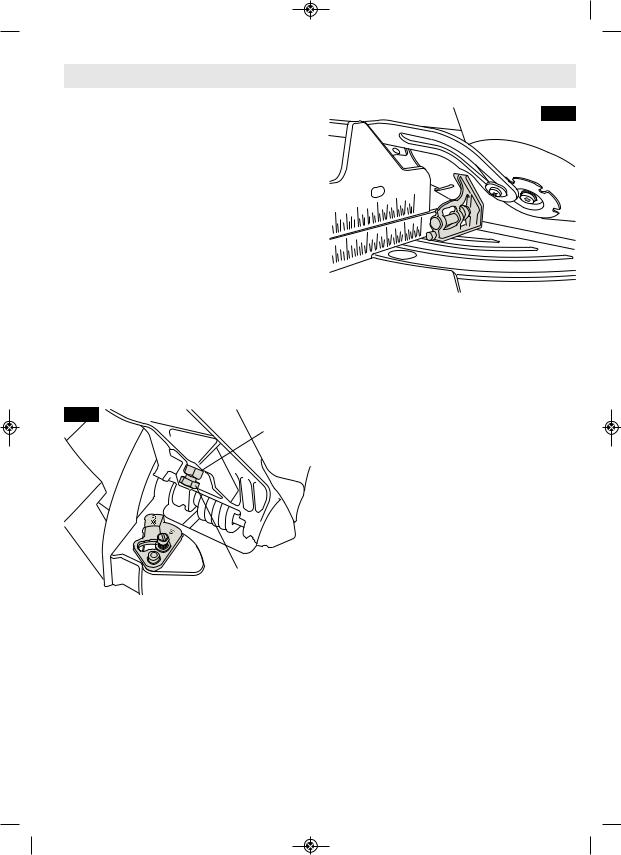
 BM 2610021316 10-11 E:BM 2610021316 10-11 E.qxp 10/17/11 11:02 AM Page 14
BM 2610021316 10-11 E:BM 2610021316 10-11 E.qxp 10/17/11 11:02 AM Page 14
Adjustments
A.Rotate the bevel stop bolt clockwise to adjust the head to the left.
B.Rotate the bevel stop bolt counter-clockwise to adjust the head to the right.
5.Follow the procedure in “Checking 0° Bevel Adjustment” to check your modifications. If further adjustment is required, repeat the steps above.
6.Once satisfactory, lock the bevel lock at 0° to prevent movement.
7.Finger tighten the lock nut in place. Once secured, tighten the lock nut with wrench.
Checking left 45° Bevel Adjustment
1.Lower head assembly and engage head assembly lock pin.
2.Rotate table to 0° miter position and lock.
3.Slide the fence completely to the left to avoid hitting it with the saw head.
4.Pull forward bevel lock lever to unlock bevel.
5.Check range of bevel range selector stop. It should be at 45°. (See Figure 11)
FIG. 11
lock Nut
Bevel Stop Bolt
6.Tilt the saw assembly to the left until you feel it stop. This is where the saw is currently set for 45° bevel cut.
7.Use a combination square to check blade squareness to the table. Place the combination square on the table and press its 45° surface against the blade. If the blade does not contact the full length of the square, follow the calibration procedure. (See Figure 12)
FIG. 12
Calibrating Blade at left 45° Bevel
Note: Use a 1/2” (13mm) wrench for adjustment.
Note: Calibrating the bevel setting automatically calibrates the 33.9° and 47° left stops.
1.Lower head assembly and engage head assembly lock pin.
2.Slide the fence completely to the left to avoid hitting it with the saw head.
3.Check bevel range selector stop located on the left side of the bevel post on the table. It should be at 45°.
4.Pull the bevel lock forward to unlock the head assembly.
5.Locate the bevel stop bolt along the left side of the bevel post. This bolt features a lock nut. (See Figure 11)
4.Loosen the bevel stop bolt a quarter turn and then loosen the lock nut. When this is complete you will be able to adjust the bevel stop bolt by hand.
A.Rotate the bevel stop bolt clockwise to adjust the head to the right.
B.Rotate the bevel stop bolt counter-clock- wise to adjust the head to the left.
5.Follow the procedure in “Checking left 45° Bevel Adjustment” to check your modifications. If further adjustment is required, repeat the steps above.
6.Once satisfactory, lock the bevel lock at 45° to prevent movement.
7.Finger tighten the lock nut in place. Once secured, tighten with wrench.
-14-
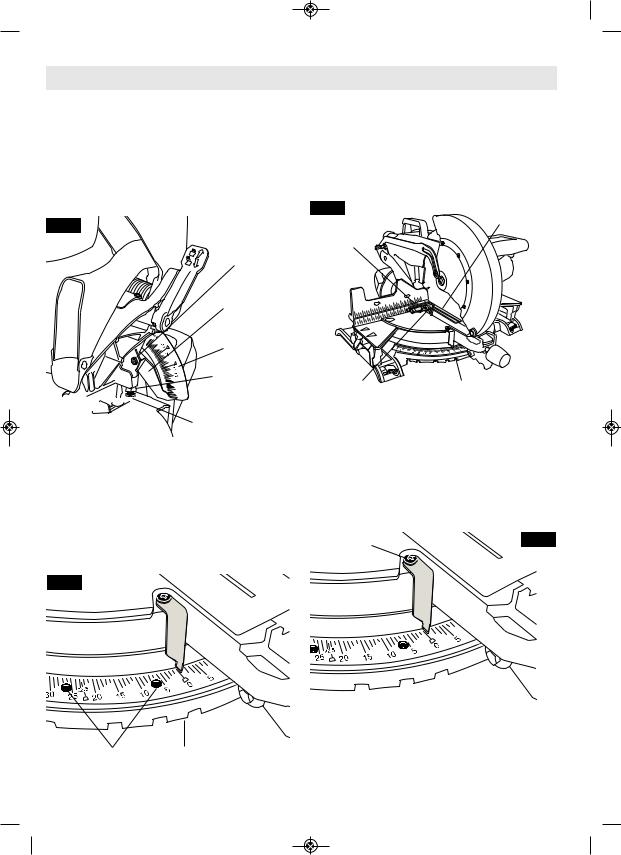
 BM 2610021316 10-11 E:BM 2610021316 10-11 E.qxp 10/17/11 11:02 AM Page 15
BM 2610021316 10-11 E:BM 2610021316 10-11 E.qxp 10/17/11 11:02 AM Page 15
Adjustments
Adjusting Bevel Scale pointer
Once you have adjusted the blade to the correct angle, make sure to adjust the Bevel Scale Pointer. To do so,
1.Loosen the screw which holds the pointer in place a quarter turn. (See Figure 13)
2.Align the pointer with the 0° line and retighten screw.
FIG. 13
Screw
Bevel Scale
pointer
Bevel Scale
lock Nut


 Bevel Stop Bolt -2° Bevel Stop
Bevel Stop Bolt -2° Bevel Stop
Miter Detent System – Adjustment procedure Calibrating Miter Detent System
1.Engage the miter detent at the 0° position. Loosen the miter lock knob 1/2 turn.
2.Look for four round holes in the miter scale plate. In each hole is a screw. Use the small end of the 6/4mm hex key or a 4mm hex key to loosen all four screws 1 to 2 turns. This will loosen the miter detent plate (see Figure 14).
FIG. 14
3.Lock saw down using the head assembly lock pin (item 36 – page 8).
4.Hold one side of a 90° combination square against the fence and rotate the table (and detent plate) until the side of the saw blade is in full contact with the other side of the square. (See Figure 15)
FIG. 15 |
Contacting |
|
Blade |
Contacting
fence
Combination |
Set Miter |
Square |
Detent 0° |
5. Tighten all four screws – loosen and reset the miter scale pointer to the “0” position.
Miter Scale pointer Adjustment
1.Rotate table to 0° position and lock in place.
2.Raise the head assembly to the full UP position.
3.Loosen the pointer adjust screw that holds the miter scale pointer in place (see Figure 16).
pointer Adjust |
FIG. 16 |
Screws |
|
Miter Scale
 pointer
pointer
4. Position the pointer to align with the 0° line. Tighten the screw.
Screws |
Detent plate |
-15-
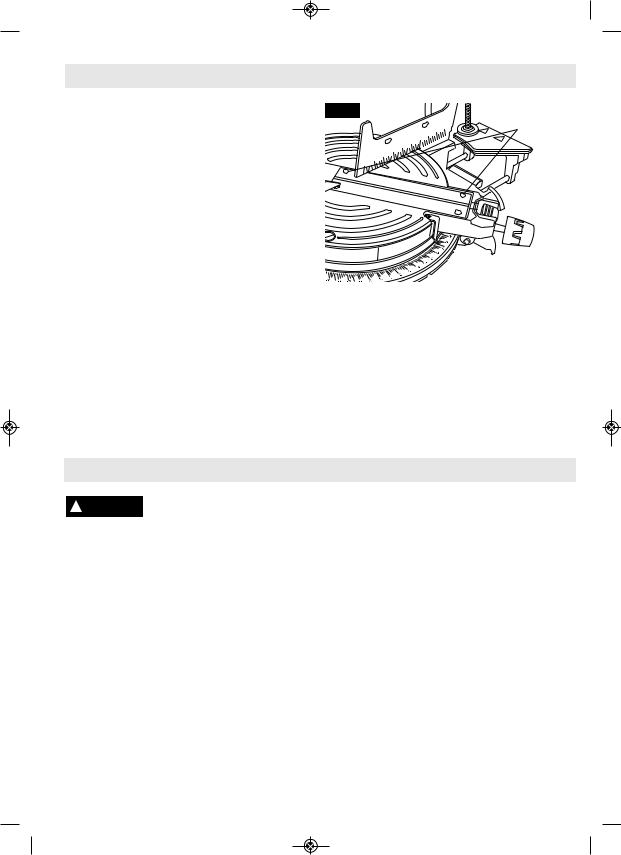
 BM 2610021316 10-11 E:BM 2610021316 10-11 E.qxp 10/17/11 11:02 AM Page 16
BM 2610021316 10-11 E:BM 2610021316 10-11 E.qxp 10/17/11 11:02 AM Page 16
Adjustments
Kerf Insert Adjustment |
FIG. 17 |
The kerf inserts should be adjusted close to the blade, but without touching the blade, to avoid tearout on the bottom of the workpiece.
1. Hold the saw head assembly down and push in the head assembly lock pin (item 36 – page 8) to keep the saw in the DOWN position.
2. Loosen the two kerf insert screws using a #2 Phillips screwdriver.
3. Adjust the kerf inserts as close to the blade (teeth) as possible without touching the blade.
4. Tighten the kerf screws.
NOTE: At extreme bevel angles, the saw blade may slightly cut into kerf insert.
Kerf Insert
Screws
Transporting and Mounting
To avoid injury, follow all statements identified below by the
BUllET (•) symbol.
•Never lift this saw by grasping the base extensions when they are in the extended position.
•Unplug electric cord and wind up. Use the hook and loop strap to hold the wrapped cord together.
•Never lift the saw by gripping any of the mechanism parts. The saw may move and cause severe injuries to your fingers or hands.
•To avoid back injury, hold the tool close to your body when lifting. Bend your knees so you can lift with your legs, not your back.
•Never lift tool by holding switch handle. This may cause serious damage to the tool.
•Never lift the miter saw by the power cord. Attempting to lift or carry the tool by the power cord
will damage the insulation and the wire connections, resulting in electric shock or fire.
•place the saw on a firm, level surface where there is plenty of room for handling and properly supporting the workpiece.
ONlY lift this saw by the cast-in carry handles at each side of the bottom of the base, top carry handle, or rear carry handle.
preparing To lift The Saw
Set bevel angle at 0° and lock in place using the bevel lock lever.
Rotate the table to either 45 or 0° and lock into place using the miter lock knob.
Lock the saw head in the DOWN position with the head lock pin.
Check that each base table extension is in the closed position and locked in place (See Figure 18).
-16-
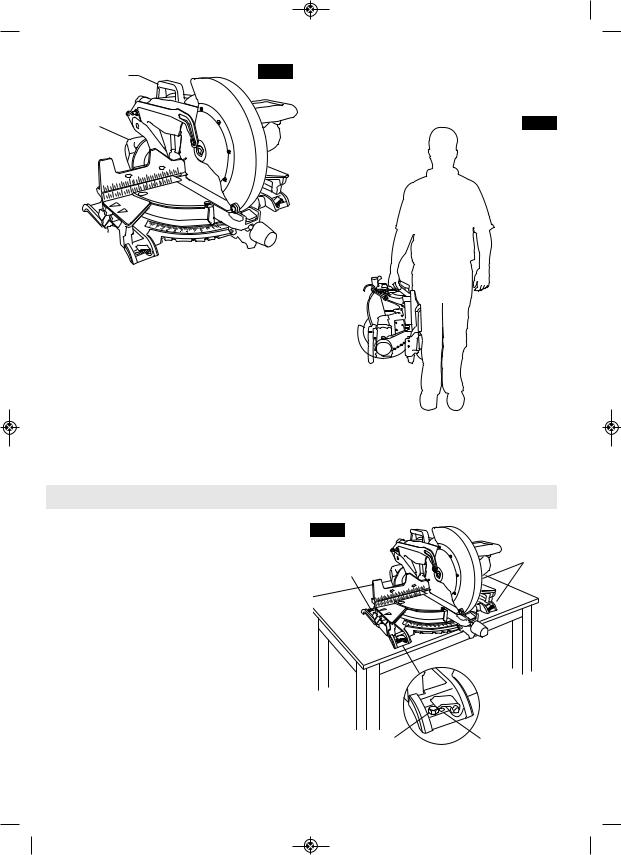
 BM 2610021316 10-11 E:BM 2610021316 10-11 E.qxp 10/17/11 11:02 AM Page 17
BM 2610021316 10-11 E:BM 2610021316 10-11 E.qxp 10/17/11 11:02 AM Page 17
Top Carrying |
FIG. 18 |
Handle |
|
Rear
Carrying
Handle
Cast-In


Carrying
Handle
lift The Saw By Rear Carry Handle
Rotate saw so the back of the saw is facing you.
Grasping the top carry handle with one hand and the rear carry handle with the other, lift the saw off the work surface. Using one hand, lower the bottom of the base in line with your leg. This is the optimal position to carry the saw one-handed. (See Figure 19)
lift The Saw By The Cast-In Carry Handles And/Or Top Carry Handle
With the saw facing you and the head mitered to 45°, grip either both cast-in carry handles located
under the base table extension or one cast-in carry handle and the top carry handle. (See Figure 18)
Continue to lift and transport comfortably.
FIG. 19
placement and Mounting
Mounting Applications Workbench permanent Attachment
1.Each of the four mounting holes should be bolted securely using 5/16" bolts, lock washers and hex nuts (not included).
2.Locate and mark where the saw is to be mounted.
3.Drill four 5/16" diameter holes through workbench.
4.Place the miter saw on the workbench, aligning holes in base with holes drilled in workbench. Install bolts, lock washers and hex nuts (See Figure 20).
FIG. 20 |
|
|
Mounting |
Rear Mounting |
Holes |
|
|
Holes |
|
Bolt Hole |
Nail Hole |
-17-

 BM 2610021316 10-11 E:BM 2610021316 10-11 E.qxp 10/17/11 11:02 AM Page 18
BM 2610021316 10-11 E:BM 2610021316 10-11 E.qxp 10/17/11 11:02 AM Page 18
Alternate Attachment
The smaller mounting holes at each corner can be used for nails or longer drywall screws.
The supporting surface where the saw is to be mounted should be examined carefully after mounting to ensure that no movement can occur during use. If any tipping or walking is noted, secure the workbench or stand before operating the miter saw.
Be careful not to over-drive nail ! CAUTION or over-torque the bolt. This
could crack foot or damage base.
Temporary Mounting Using Clamps
•If necessary, clamp the miter saw to a workbench or table top.
•Place two or more “C” clamps on the clamping areas and secure (see Figure 21). There are clamping areas at all four corners of the saw.
•Be careful not to place clamps over the base extension clamping levers (see Figure 21).
•Mounting with clamps may prevent access to some wide miter angles.
FIG. 21
Clamping
Areas
Clamping Areas
Basic Saw Operations
Switch Activation
For safety, the switch lever is designed to prevent accidental starts. To operate safety switch, slide the switch “Lock-OFF” toggle with either thumb to disengage the lock, then pull the power switch lever and release the switch “Lock-OFF” toggle (Figure 22). When the power switch lever is released, the switch “Lock-OFF” toggle will engage the power switch lever automatically, and the lever will no longer operate until either “Lock-Off” toggle is engaged again(see Figure 22)
NOTE: Switch lever can accommodate a padlock with a long shackle of up to 1/4" in diameter (not provided with miter saw) to prevent unauthorized use.
pad lock |
FIG. 22 |
|
Switch |
||
Hole |
||
“lock-Off” |
||
|
||
|
Toggle |
power Switch lever
-18-
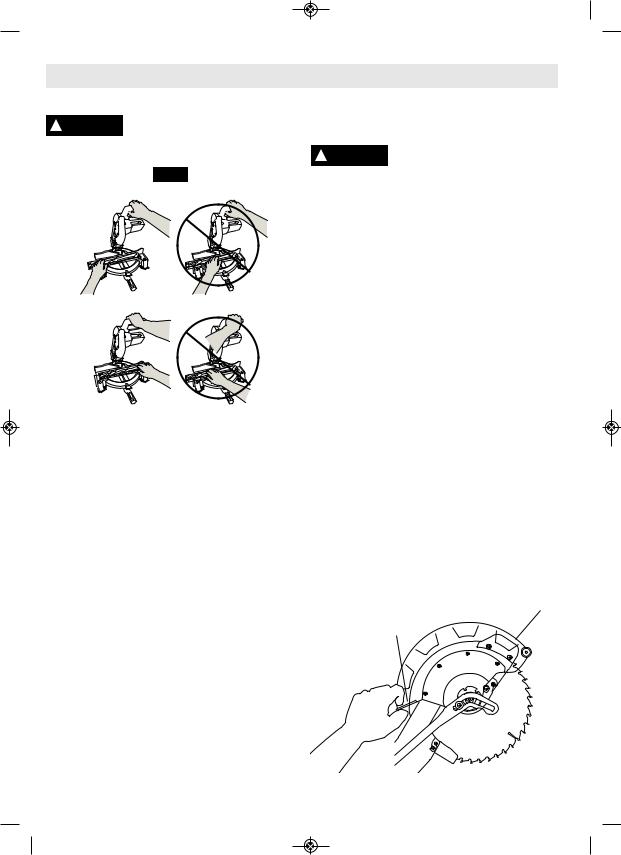
 BM 2610021316 10-11 E:BM 2610021316 10-11 E.qxp 10/17/11 11:02 AM Page 19
BM 2610021316 10-11 E:BM 2610021316 10-11 E.qxp 10/17/11 11:02 AM Page 19
Basic Saw Operations
Body and Hand position
! WARNING position your body and hands properly to make cutting easier
and safer. Observe the following instructions (See figure 23).
FIG. 23
Correct Use |
Incorrect Use |
Correct Use |
Incorrect Use |
•Never place hands near cutting area. Keep hands outside the “No Hands Zone”. The “No Hands Zone” is defined as the area between marked lines on the left and right side of the table, including the entire Table and portion of the Fence within these marked lines. This zone is labeled by “No Hands” symbols placed along side the marked lines on the table. The marked “No Hands Zone” on the product is valid for making cut at zero miter and zero bevel. When making cut other than at zero miter and zero bevel setting, always check to ensure your hand is placed at least six (6) inches away from the projected path of the saw blade.
Always use clamp to hold workpiece against the table and fence when making compound miter cuts. Do not support by hand.
•Hold workpiece firmly to the fence to prevent movement.
•Keep hands in position until trigger has been released and blade has stopped completely.
•Keep feet firmly on the floor and maintain proper balance.
•Follow the miter arm when mitering left or right. Stand slightly to the side of the saw blade.
•Sight through the lower guard if following a pencil line.
•Before making any cut, with the power off, lower the blade to preview the blade path - dry run.
The lower guard may not automatically open under certain
cutting conditions.
•Typically this may occur when trying to cut workpieces that are near the maximum cutting height capacity. Under these conditions, the workpiece can stop the lower guard movement before the downward motion of the arm could preopen the lower guard. If this occurs:
•Workpiece must be securely clamped. This frees your left hand to raise the guard 1 by the lip 2 just enough to clear the workpiece. (See Figure 24)
•Start the saw and begin your cut.
•Once you have cleared the position where the lower guard may bind, release the guard and it will continue to raise automatically as you cut.
! WARNING |
Be aware of the path of the saw |
|
blade. Make a dry run with the |
|
saw Off by conducting a simulated cutting cycle, and observe the projected path of the saw blade. Keep hands at least six (6) inches away from the projected path of the saw blade.
DRY RUN—It is important to know where the blade will intersect with the workpiece during cutting operations. Always perform the simulated cutting sequence with the power tool switched OFF to gain an understanding of the projected path of the saw blade. Mentally note where the path of saw blade will fall and set up your work to keep your hands and arms at least six (6) inches away from the projected path of the spinning blade. Adjust your clamps and fences so that the smooth lower guard and cutting action is not interfered with during cutting operation.
FIG. 24 |
1 |
|
2
-19-
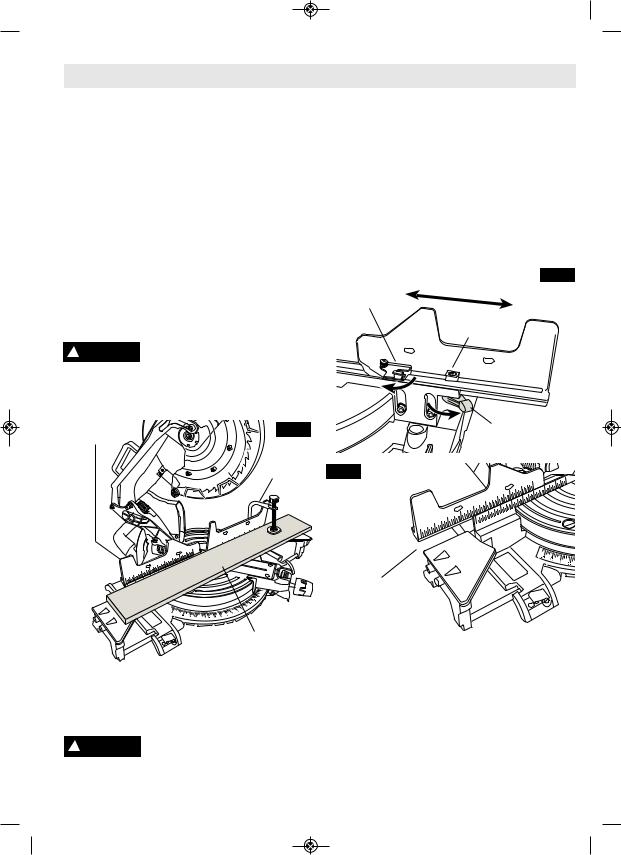
 BM 2610021316 10-11 E:BM 2610021316 10-11 E.qxp 10/17/11 11:02 AM Page 20
BM 2610021316 10-11 E:BM 2610021316 10-11 E.qxp 10/17/11 11:02 AM Page 20
preparing for Saw Operations
Workpiece Support
Clamps
Using the Workpiece Clamp – This clamp easily secures a workpiece to the table or base.
1.Insert the clamp’s knurled bar down into a clamp post hole; there are two post holes located in the base behind the fence. The knurled end must be in the post at least 1/2".
2.Slide the clamp down until its rubber foot contacts the workpiece.
3.Adjust the clamp height so it does not touch the sliding fence.
4.Rotate the clamp’s knob until the workpiece is firmly held in place (See Figure 25).
5.Move saw head up and down and forward and back to be sure it clears the clamp.
There may be extreme compound cuts where clamp cannot be used. Support workpiece with your hand out-
side the “No Hands” zone. Do not try to cut short pieces that cannot be clamped and cause your hand to be in the “No Hands” zone.
Alternative |
FIG. 25 |
location |
|
 Clamp
Clamp
Workpiece
Clamps – Other hold-down devices such as C- clamps can be used to hold the workpiece firmly against the table and the fence. Make sure the clamps are clear of the cutting path.
Sliding fences
! WARNING To provide sufficient (minimum 6") spacing from hand to saw
blade, extend the sliding fence and base exten-
sions when making extreme bevel, miter or compound cuts.
Operating Sliding fence
1.Pull the fence lock lever toward front of tool to loosen fence (See Figure 26).
2.Slide fence to the desired position. (See Figure 27)
3.Push the lock lever toward rear of tool to lock fence position. (See Figure 26)
FIG. 26
Cover plate Tab
Adjustment
Screw
fence lock lever
FIG. 27
Sliding
fence
Removing Sliding fences
1.Lift up on the cover plate tab and rotate it away from the fence. (See Figure 26)
2.Push the lock lever toward front of saw to loosen the fence.
3.Slide the fence all the way out, away from the saw head.
4.Lift up on the sliding fence to remove.
-20-
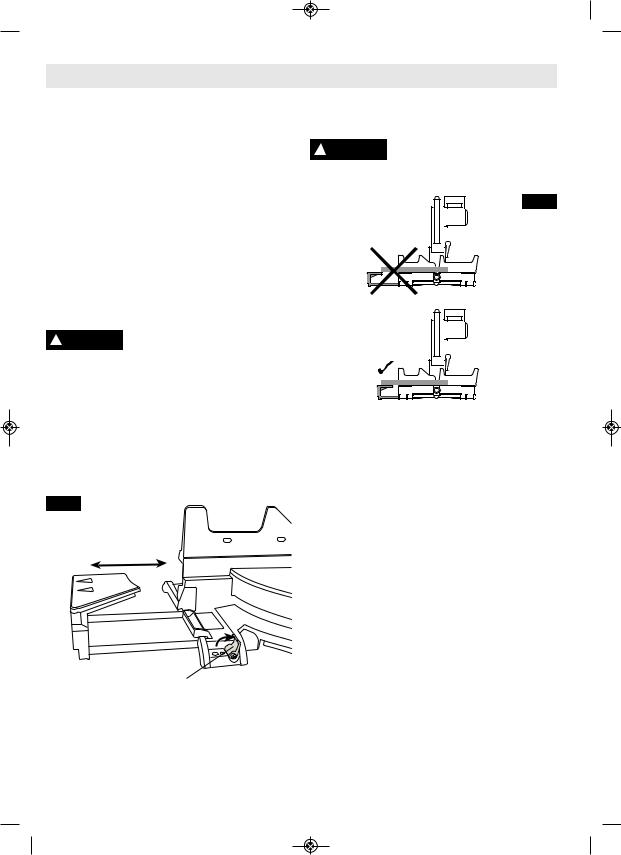
 BM 2610021316 10-11 E:BM 2610021316 10-11 E.qxp 10/17/11 11:02 AM Page 21
BM 2610021316 10-11 E:BM 2610021316 10-11 E.qxp 10/17/11 11:02 AM Page 21
Basic Saw Operations
Adjusting Sliding fence lock lever
To tighten lock: If the sliding fence does not operate as described, it needs adjustment. Remove sliding fence – (see page 20).
1.Push firmly down on the locking block to expose the adjustment screw – Using a #2 Phillips screwdriver, turn the screw 1/12 turn to the next notch in block.
A:To tighten lock: turn the screw counter-clockwise.
B:To loosen lock: turn the screw clockwise.
2.Replace sliding fence by putting its large square hole over the locking block. Slide fence fully in and close the cover plate tab. It should move freely and be locked tightly anywhere along its range of travel.
long Workpiece Support
! WARNING long workpieces have a tendency to tip over unless
clamped down and properly supported from underneath.
Operating Base Extensions – These extensions provide extra workpiece support and are especially useful when cutting long workpieces. To reposition the extensions, simply unlock the base extension lock levers, reposition the extensions and lock the levers (see Figure 28). The right extension lock lever tightens by rotating clockwise and the left lock lever tightens by rotating counterclockwise.
FIG. 28
lock lever
Additional Workpiece Support
Blocks – Long pieces need extra support. The base height is 4 inches. Cut two 2x4 pieces to 4" in length and fasten together. Boards of these thick-
ness and height can be used to create auxiliary support extensions for long workpieces.
Always adjust the sliding base extension to support workpiece.
Unsupported workpiece can move out of position during cut and cause injury and/or tol damage.
FIG. 29
Auxiliary fence Making an Auxiliary fence
Certain types of molding need a fence face extension because of the size and position of the workpiece. Holes are provided in the fence to attach an auxiliary fence. The auxiliary fence is used with the saw in the 0° bevel position only.
To fasten from front:
1.Place a piece of wood a minimum of 1/2" thick x 5-1/2" tall against the miter saw fence (see Figure 30). The right side should be only 2-3/4" tall to avoid motor interference during miter rotating. Check that auxiliary fence assembly does not interfere with head assembly. (See Figure 30 & 31).
2.Mark the locations of the support holes on the wood from the back side of the fence.
3.Drill and countersink the holes on the front of the support board.
4.Fasten from front of fence: Attach (each) auxiiary fence using two (2) 3/16" flat head machine bolts. With 3/4" auxiliary fence, use 1-1/2" long bolts Secure behind metal fence with washer and #5 machine nuts.
5.Make a full depth cut to create the blade slot. Check for interference between the auxiliary fence and the lower blade guard. Make adjustments as necessary.
-21-
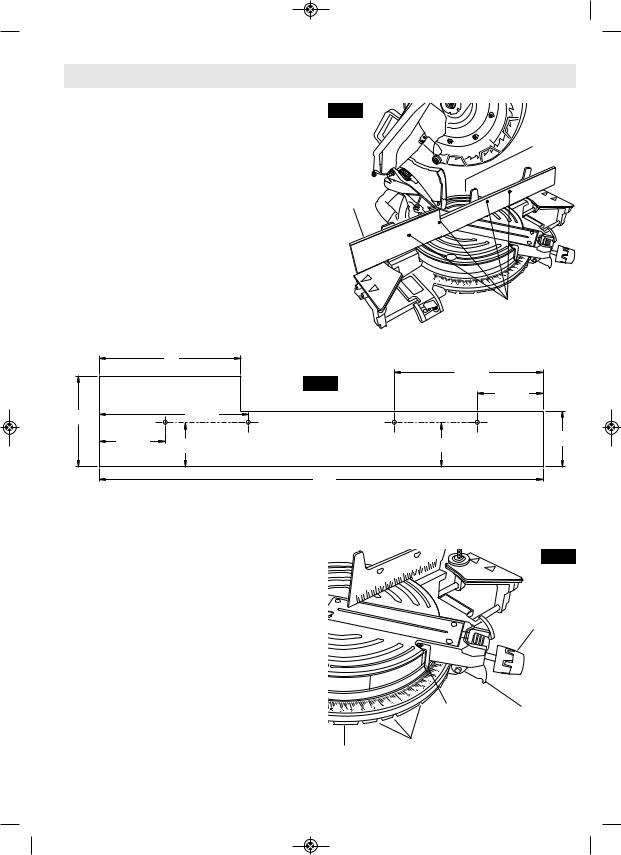
 BM 2610021316 10-11 E:BM 2610021316 10-11 E.qxp 10/17/11 11:02 AM Page 22
BM 2610021316 10-11 E:BM 2610021316 10-11 E.qxp 10/17/11 11:02 AM Page 22
Basic Saw Operations
fasten from back of fence:
Use minimum 3/4" auxiliary fence and 1/4" round head wood screws (3/4" long).
1.Drill four pilot holes through auxiliary fence and run screws from rear of metal fence.
2.Repeat test cut.
! WARNING |
Check for interference between |
|
auxiliary fence and saw head |
|
componenents by performing a dry run. Fence interference can prevent proper saw operation and cause injury and/or tool damage.
FIG. 30
Blade
Slot
Auxiliary

fence
flat Head Machine Screws
|
|
7" |
|
|
|
|
|
7-3/8" |
|
|
|
|
FIG. 31 |
3-1/4" |
|
|
|
|
|
5-1/2" |
|
7-3/8" |
|
|
|
|
|
|
|
|
3-1/4" |
2-3/16" |
2-3/16" |
2-3/4" |
|
|
|
||
|
|
|
22" |
|
Using Miter Detent System
1.Loosen the miter lock knob about 1/2 turn. (See Figure 32)
2.Grip the lock knob, and then reach down with your index finger to pull up on the miter detent lever – pull lever until it is out from the detent plate.
3.While gripping the lock knob and lever, rotate the saw’s table. Stop table rotation at the desired angle as indicated by the miter scale pointer.
4.Release the lever into a detent in the detent plate or at an angle between detents. If close to a detent, use the detent override feature.
5.Tighten the miter lock knob before cutting.
FIG. 32
|
Miter |
|
|
lock Knob |
|
Miter Scale |
Miter |
|
Detent lever |
||
pointer |
||
|
Detents
Detent
plate
-22-
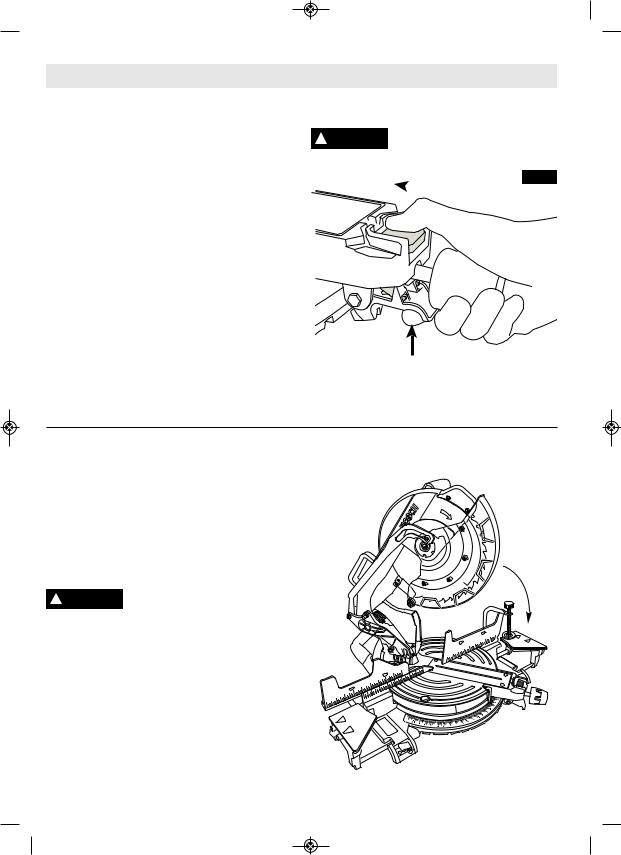
 BM 2610021316 10-11 E:BM 2610021316 10-11 E.qxp 10/17/11 11:02 AM Page 23
BM 2610021316 10-11 E:BM 2610021316 10-11 E.qxp 10/17/11 11:02 AM Page 23
Basic Saw Operations
Miter Detent Override
The miter detent override system locks out the automatic detent action. When the desired miter angle is close to a standard detent slot, this feature will hold the detent lever wedge from engagement (i.e., the user wants to be at 44-1/2°, but detent wedge wants to pop into the 45° detent). When the detent override is used, the detent system is disabled and the table will move smoothly to any position within its range.
Engaging / Disingaging the Miter
Detent Override
1.Pull up and hold the miter detent lever – the lever is located under the turntable’s front arm (see Figure 33).
2.Press down on the top half of the detent override button and then release hold of the detent lever. The override button will remain in the DOWN position (see Figure 33).
3.The turntable is free to rotate.
4.To disengage, lift miter detent levers.
With the table free to rotate, the miter lock knob must be tight-
ened before attempting any cutting.
FIG. 33
 Step 1
Step 1
Step 2
Chop Cut
What’s a Chop Cut – Saw features
• A “chop cut” is a cross cut at 0°. |
FIG. 34 |
• A chop cut can cut pieces with a width of 8" (nom- |
|
inal) or less. |
|
follow these instructions for making |
|
your chop cut: |
|
1. Properly position workpiece. Make sure work- |
|
piece is clamped firmly against the table and the |
|
fence. |
|
! WARNING Use clamping position that does |
|
not interfere with operation. Before switching on, lower head assembly to make sure clamp clears guard and head assembly.
2. Activate the switch. Lower the head assembly and make your cut (see Figure 34).
3. Wait until blade comes to a complete stop before returning head assembly to the raised position and/or removing workpiece.
-23-
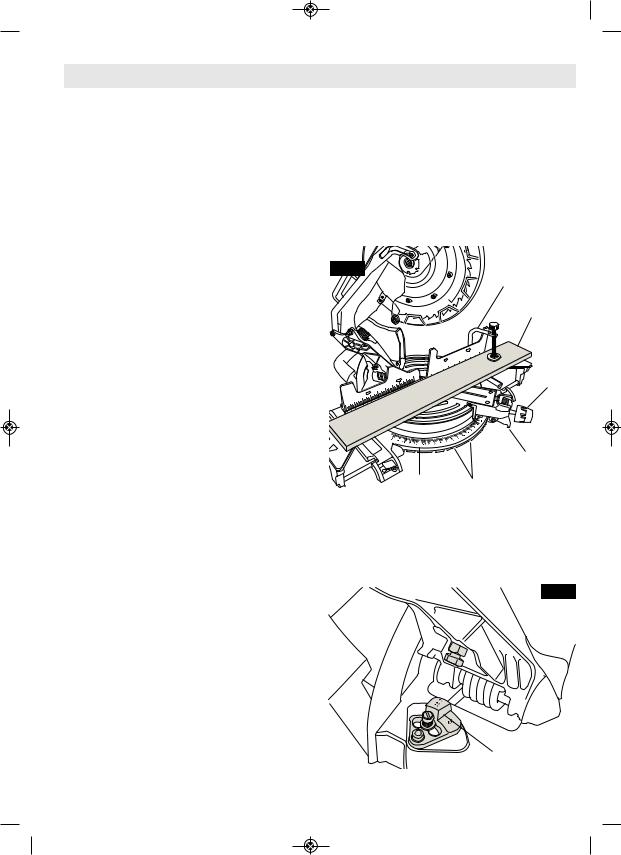
 BM 2610021316 10-11 E:BM 2610021316 10-11 E.qxp 10/17/11 11:02 AM Page 24
BM 2610021316 10-11 E:BM 2610021316 10-11 E.qxp 10/17/11 11:02 AM Page 24
Basic Saw Operations
Miter Cut
•A miter cut is a cross-cut made at 0° bevel and any miter angle in the range from 52° left and right.
•The miter scale shows the angle of the blade relative to the fence angle.
•Positive detents have been provided for fast and
accurate mitering at 0°, 15°, 22.5°, 31.6° and 45° left and right.
•The crown molding detents (left and right) are at 31.6° (See Cutting Crown Molding for more information page 28).
•For precision settings at angles next to the detents, use the detent override to lock out the detent. This prevents the wedge on the detent lever from slipping back into the detent.
•The kerf inserts should be as close to the blade as possible without touching the blade (see Kerf Inserts for adjustment procedures).
follow these instructions for making your miter cut:
1.Loosen miter lock knob. Lift miter detent lever and move the saw to the desired angle, using either the detents or the miter scale. Tighten miter lock knob (Figure 35).
2.Extend the base extensions and fence on the side on which the cut will be made. (See Sliding Fence and Base Extension on page 20 & 21).
3.Properly position workpiece. Make sure workpiece is clamped firmly against the table or the fence.
! WARNING |
Use clamping position that does |
|
not interfere with operation. Be- |
|
fore switching on, lower head assembly to make sure clamp clears guard and head assembly.
4.Follow procedures for chop cut (see page 23).
5.Wait until blade comes to a complete stop before returning head assembly to the raised position and/or removing workpiece.
FIG. 35 |
Material |
|
Clamp |
|
Workpiece |
Miter |
lock |
Knob |
Miter Detent
lever
Miter Detents
Scale
Bevel Cut
A “bevel cut” is a cross-cut made with the blade perpendicular to the fence and with the table set at 0° miter. The blade can be tilted at any angle within the saw’s range: 47° left and -2° right from the vertical.
The bevel scale is sized and positioned for easy reading. And the side bevel lock lever is to lock and unlock the various settings.
A rotating Left Bevel Stop indicator allows you to set the most common bevel stops – 0°, 33.9°, 45° and 47° Left. The 33.9° bevel stop is for cutting 38° “spring angle” crown molding flat on the table. (See Compound Cuts for more information.) (See Figure 36)
FIG. 36
33.9° left Bevel Stop
-24-
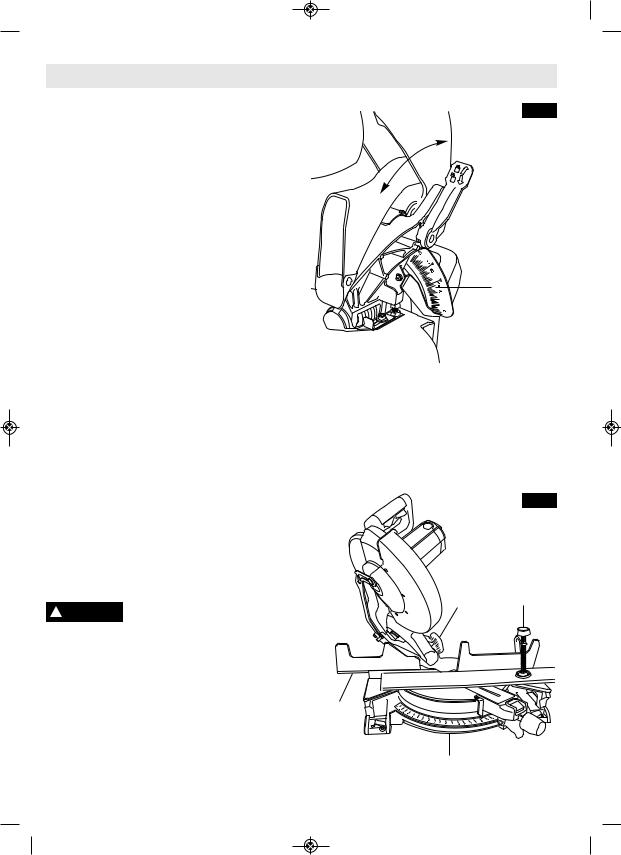
 BM 2610021316 10-11 E:BM 2610021316 10-11 E.qxp 10/17/11 11:02 AM Page 25
BM 2610021316 10-11 E:BM 2610021316 10-11 E.qxp 10/17/11 11:02 AM Page 25
Basic Saw Operations
A -2° Right Bevel Stop is also available for back cutting applications. Simply slide this stop forward and back to engage the 0° stop and disengage for -2° stop. (See Figure 37)
Setting the Saw to Make A Bevel Cut
Extend the base extension and fence (See Sliding Fence and Base Extension on page 20 & 21)
With one hand, pull the bevel lock lever forward to unlock the saw head. (See Figure 37)
Adjust your left bevel stop to one of the three preset locations, – 33.9°, 45° and 47° Left, if desired, tilt head left until you reach the desired angle on your bevel scale. (See Figure 37)
Lock the bevel lock by pushing it toward the back of the saw.
Follow the chop cut procedures in the manual.
Compound Cuts
•A “compound cut” is a cross-cut made with the blade both at a a miter angle and at a bevel angle.
•Because it may take several tries to obtain the desired compound angle, perform test cuts on scrap material before making your cut.
follow these instructions for making your compound cut:
1. Extend the base extensions and fence. (See Sliding Fences and Base Extensions on page 20 & 21.)
2. Properly position workpiece. Make sure workpiece is clamped firmly against the table or the fence(Figure 38).
! WARNING Use clamping position that does not interfere with opera-
tion. Before switching on, lower head assembly to make sure clamp clears guard and head assembly.
3.Set miter and bevel angles according to the instructions on page 24 and 25 for miter and bevel cuts.
4.Follow the procedures for chop cut.
5.Wait until blade comes to a complete stop before returning head assembly to the raised position and / or removing workpiece.
FIG. 37
lock
Unlock 

Bevel
Scale
 -2° Bevel Stop
-2° Bevel Stop
Right
Cutting crown molding flat on the table requires compound cuts. See cutting crown molding section on page, 28 & 29.
FIG. 38
Bevel Material
Scale Clamp
Sliding
fence
Miter Scale
-25-
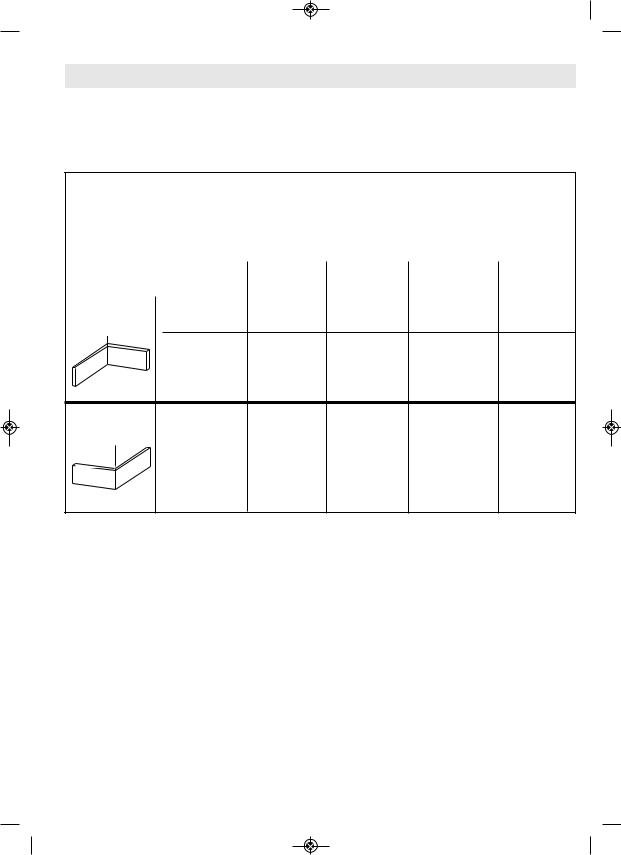
 BM 2610021316 10-11 E:BM 2610021316 10-11 E.qxp 10/17/11 11:02 AM Page 26
BM 2610021316 10-11 E:BM 2610021316 10-11 E.qxp 10/17/11 11:02 AM Page 26
Saw Operations
Cutting Base Molding
Base molding can be cut vertical against fence or flat on the table. The maximum size that can be vertical on the fence is 6-3/4.
Follow the table for helpful hints on cutting base molding for corners that have 90° angles.
|
BASE MOlDING CUTTING INSTRUCTIONS |
|
|||
LOCATION OF |
Molding in Vertical Position: |
Molding in Horizontal Position: |
|||
|
MOLDING |
Back of molding is |
Back of molding is flat |
||
|
ON SAW |
against the fence |
on the table |
||
Bevel Angle |
Bevel = 0° |
Bevel = 45° |
|||
|
|
|
|
|
|
Molding Piece Being Cut |
To left of |
To right of |
To left of |
To right of |
|
|
|
corner |
corner |
corner |
corner |
|
|
|
|
|
|
Inside |
Miter Angle |
Left at 45° |
Right at 45° |
0° |
0° |
corner of wall
Right
Outside corner of wall
Left |
Right |
|
|
Position of |
Bottom |
Bottom |
Top against |
Bottom |
molding on Saw |
against table |
against table |
fence |
against fence |
|
|
|
|
|
|
|
|
Finished |
Keep left |
Keep right |
Keep left |
Keep left |
|
side |
side of cut |
side of cut |
side of cut |
side of cut |
|
Miter Angle |
Right at 45° |
Left at 45° |
0° |
0° |
|
|
|
|
|
|
|
Position of |
Bottom |
Bottom |
Bottom against |
Top against |
molding on Saw |
against table |
against table |
fence |
fence |
|
|
|
|
|
|
|
|
Finished |
Keep left |
Keep right |
Keep right |
Keep right |
|
side |
side of cut |
side of cut |
side of cut |
side of cut |
Cutting Crown Molding
Crown molding cuts must be positioned properly to fit exactly.
There are two ways to cut crown molding: flat on table or angled to table and fence.
Crown molding’s “spring angle” is the angle between the back of the molding and the bottom flat surface that fits against the wall.
This miter saw has special miter detents at 31.6° and a bevel detent at 33.9°. These detents allow you to easily position most crown moldings flat on the table and make precise cuts for 90° corners. (These detents are only for use with crown moldings that have a 38° “spring angle”.) NOTE: These detents cannot be used with 45° crown molding.
See also pages 29 for miter and bevel angle charts for cutting crown moldings that have 38° and 45° spring angles and the material is laid flat on the miter saw base. Each chart lists the exact miter and bevel settings required for a wide range of corner angles.
Even though these angles are standards, most rooms do not have angles of exactly 90°, therefore, you will need to fine tune your settings.
The optional Bosch DAF220K MiterFinder Digital Anglefinder/Protractor measures spring angles and corner angles, then automatically determines the exact miter and bevel settings necessary to make each crown molding cut fit perfectly.
-26-
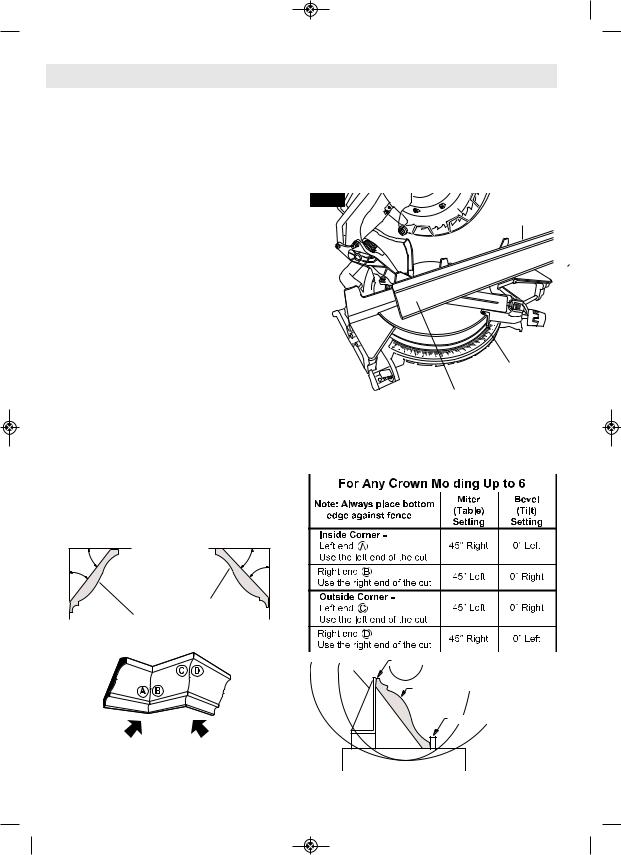
 BM 2610021316 10-11 E:BM 2610021316 10-11 E.qxp 10/17/11 11:02 AM Page 27
BM 2610021316 10-11 E:BM 2610021316 10-11 E.qxp 10/17/11 11:02 AM Page 27
Saw Operations
Crown Molding Angled to Table and fence
The preferred method for cutting crown molding with this saw is with the molding lying flat on the table.
The advantage to cutting molding angled against fence is that no bevel setting is required. Only the miter angle is adjusted.
The maximum crown molding width that can be cut and angled to table and fence is 6".
When cutting crown molding in this fashion it is recommended to purchase and use the optional MS1233 Crown Stop Set (see page 37).
follow these instructions for cutting crown molding angled to table and fence.
1.Position the molding so the bottom (decorative part, which is installed against the wall) is against the fence.
2.For 90° corner, set the miter angle using chart below. Tighten the miter lock knob.
3.Support crown molding against the fence (see “Body and Hand Position” on page 19.)
4.Follow the procedures for chop (See pages 23).
5.Wait until blade comes to a complete stop before
returning head assembly to the raised position and/or removing workpiece.
NOTE: Always take a test cut using scrap to confirm correct angles.
FIG. 39
Bottom edge of molding
45º Miter
Crown Molding Angled
Against fence
Miter and Bevel Settings for Standard Crown Molding Cuts (When Workpiece Angled Against fence)
Assumptions: Molding is milled consistently. |
|
|
" |
|
|||
Corner is 90°. |
|
|
|
|
|
|
For other corner angles, divide actual measurement by 2.
Ceiling |
Ceiling |
|
|
45° |
|
Wall |
45° |
Wall |
|
45/45° Crown Molding |
|
38/52° Crown Molding |
|
|
38° Spring Angle |
45° Spring Angle |
Inside |
|
Outside |
|
||
|
||
Corner |
|
Corner |
Refer to Chart
Bottom Edge |
|
Fence |
Cutting – Angled |
Molding Placed |
to Table and |
Upside Down |
fence |
Crown Stop |
|
Table |
|
-27-
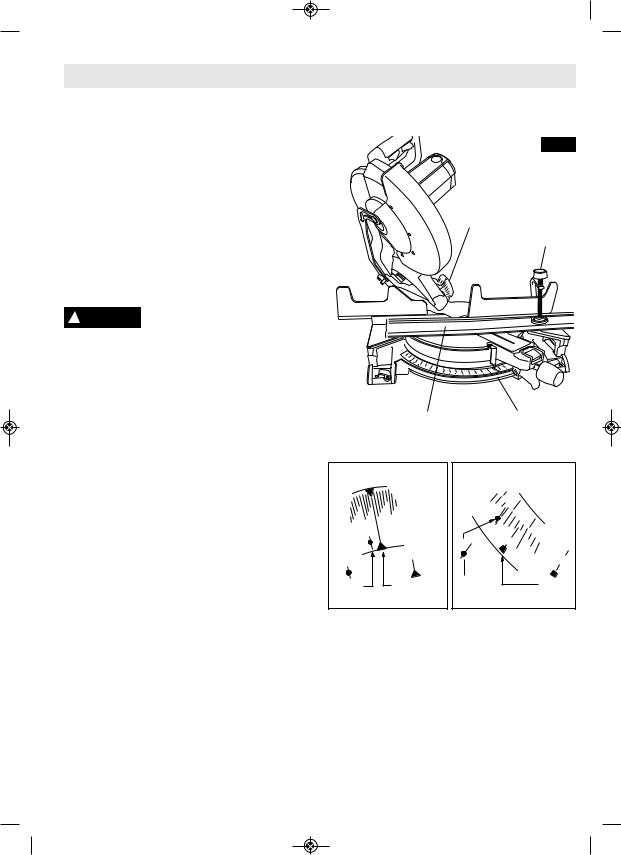
 BM 2610021316 10-11 E:BM 2610021316 10-11 E.qxp 10/17/11 11:02 AM Page 28
BM 2610021316 10-11 E:BM 2610021316 10-11 E.qxp 10/17/11 11:02 AM Page 28
Saw Operations
Crown Molding laying flat on Table
•Notes: Position workpiece with its back flat on the saw table.
•Always place top edge of molding against fence (Decorative edge is at the bottom of crown molding.)
Crown molding’s “spring angle” is the angle between the back of the molding and the bottom flat surface that fits against the wall.
1.For 90º corner, set the bevel and miter angles using Charts below. Tighten the miter lock knob and the bevel lock lever (See Figure 40).
2.Position molding on saw table. Clamp workpiece in place using the quick clamp.
Use clamping position that does ! WARNING not interfere with operation. Be-
fore switching on, lower head assembly to make sure clamp clears guard and head assembly.
3.Follow procedures for chop cut (see page 23).
4.Wait until blade comes to a complete stop before returning head assembly to the raised position and/or removing workpiece.
NOTE: AlWAYS TAKE A TEST CUT USING SCRAp TO CONfIRM CORRECT ANGlES.
FIG. 40
Bevel
Scale Material
Clamp
Crown Molding |
Miter Scale |
Crown Molding lying flat
Bevel Scale Settings
30 |
40 |
|
.9 |
||
|
||
|
33 |
|
30 |
33 |
|
|
.9 |
|
For 45° |
For 38° |
|
Spring Angle |
Spring Angle |
Miter Scale Settings
35 |
|
|
. |
|
|
3 |
|
|
35 |
31. |
|
35 |
|
|
6 |
|
|
. |
|
|
3 |
30 |
|
|
31. |
|
|
|
6 |
For 45° |
|
For 38° |
Spring Angle |
Spring Angle |
|
-28-
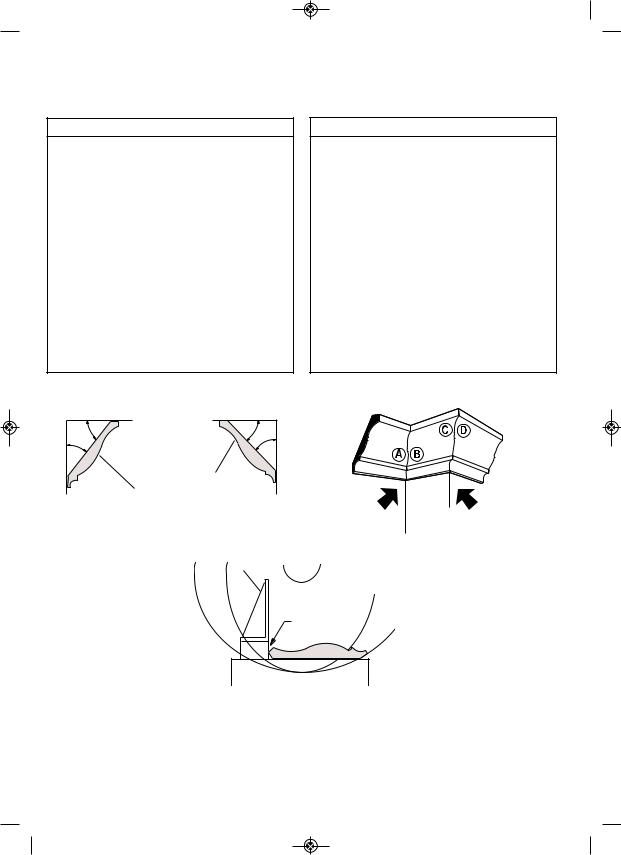
 BM 2610021316 10-11 E:BM 2610021316 10-11 E.qxp 10/17/11 11:02 AM Page 29
BM 2610021316 10-11 E:BM 2610021316 10-11 E.qxp 10/17/11 11:02 AM Page 29
Miter and Bevel Settings for Standard Crown Molding Cuts
(When Crown Molding is lying flat on Table) Assumptions: Molding is milled consistently. Corner is exactly 90º.
Molding Spring Angle is 38 degrees
|
Miter |
Bevel |
|
(Table) |
(Tilt) |
|
Setting |
Setting |
|
|
|
Inside Corner |
|
|
Left end (A) |
(31.6) Right |
(33.9) Left |
Use the left end |
|
|
of the cut |
|
|
Right end (B) |
(31.6) Left |
(33.9) Right |
Use the right end |
|
|
of the cut |
|
|
Outside Corner |
|
|
Left end (C) |
(31.6) Left |
(33.9) Right |
Use the left end |
|
|
of the cut |
|
|
Right end (D) |
(31.6) Right |
(33.9) Left |
Use the right end |
|
|
of the cut |
|
|
Molding Spring Angle is 45 degrees
|
Miter |
Bevel |
|
(Table) |
(Tilt) |
|
Setting |
Setting |
|
|
|
Inside Corner |
|
|
Left end (A) |
(35.3) Right |
(30.0) Left |
Use the left end |
|
|
of the cut |
|
|
Right end (B) |
(35.3) Left |
(30.0) Right |
Use the right end |
|
|
of the cut |
|
|
Outside Corner |
|
|
Left end (C) |
(35.3) Left |
(30.0) Right |
Use the left end |
|
|
of the cut |
|
|
Right end (D) |
(35.3) Right |
(30.0) Left |
Use the right end |
|
|
of the cut |
|
|
Ceiling |
Ceiling |
|
|
|
45° |
|
|
Wall |
45° |
Wall |
|
|
45/45° Crown Molding |
|
|
38/52° Crown Molding |
|
|
|
38° Spring Angle |
45° Spring Angle |
Inside |
Outside |
|
|
||
|
|
Corner |
Corner |
Fence |
Top of Molding |
Against Fence |
Table |
-29-

 BM 2610021316 10-11 E:BM 2610021316 10-11 E.qxp 10/17/11 11:02 AM Page 30
BM 2610021316 10-11 E:BM 2610021316 10-11 E.qxp 10/17/11 11:02 AM Page 30
Saw Operations
Crown Molding Auxiliary fence
When making a compound cut on a molding lying flat on the table, narrow cut-off pieces (2" or less in width)
may be propelled at high speed over the fence and beyond the back of the tool (see figure 41). Use auxiliary fence as instructed and shown in figures below.
An auxiliary fence is used to add support to the cutoff workpiece such as large crown molding when cut flat on the table (see Figure 42). It will reduce splintering and movement of the unsupported cut-off piece of wood after the cut is made.
Making an Auxiliary fence:
Required pieces:
Wood Board (described below)
4 – Flat Head Machine Screws – 1/4" diameter;
2-1/2" long
4 – 1/4" Flat Washers
4 – Nuts
1.Cut a nominal 1" x 2" wood board to a length of 21-3/14" long. NOTE: 1 x 2" nominal equals 3/4" x 1-1/2" actual. 3/4" plywood cut to size may be substituted.
FIG. 41
2.Drill four holes through the board using a 5/16" diameter drill bit. Countersink the holes deep enough so that the flat head screws will rest below the front work surface – use a 1/2" diameter drill bit (see Figure 43, 44 & 45).
Remove the sliding fences from the tool – see page 21.
1.Place the flat head screws through the holes in the auxiliary fence, then the holes in the stationary fence on the tool.
2.Place the washers and nuts over the screw threads and against the stationary fence. Tighten nuts.
first-Time Use of the Auxiliary fence:
NOTE: The first time the auxiliary fence is used, it will be cut through by the saw blade – cutting through creates minimal clearance which reduces splintering on the workpiece. Set the miter angle and the bevel angle required before making the first cut. Clamp the workpiece, then make cut – example: compound cutting large crown molding flat on the table (see Figure 39).
FIG. 42
Small Cut-off Piece |
Stationary Fence |
Small Cut-off Piece |
Auxiliary Fence |
-30-
